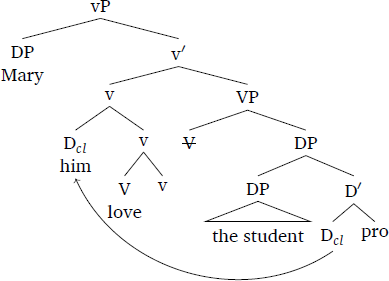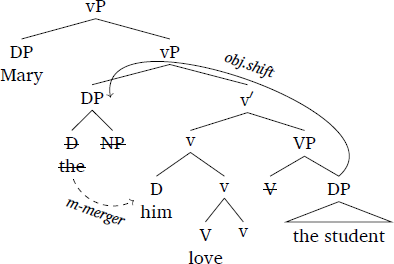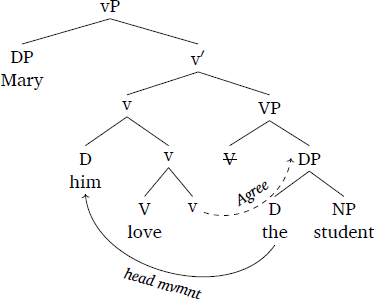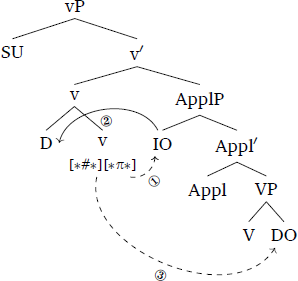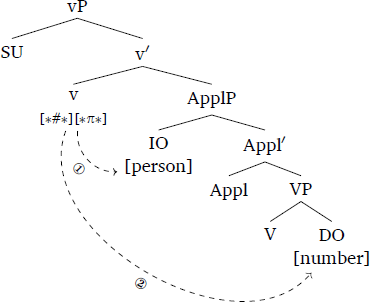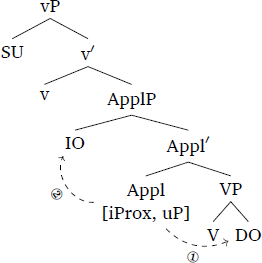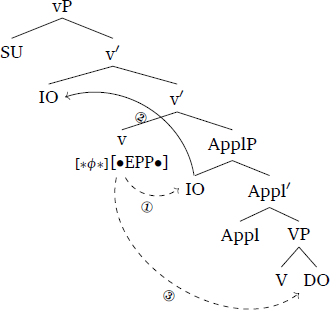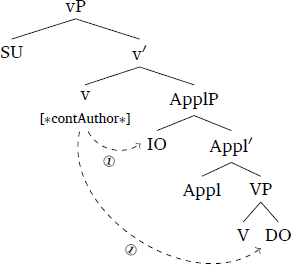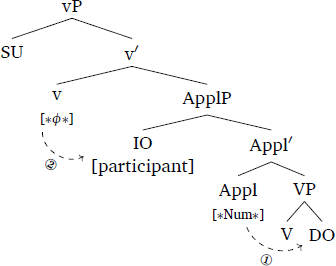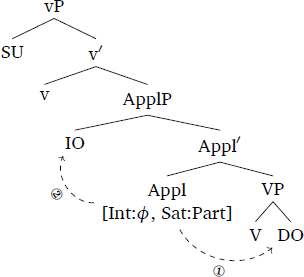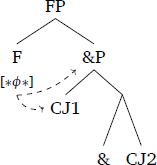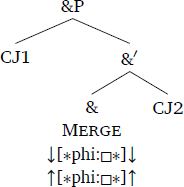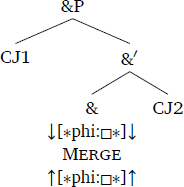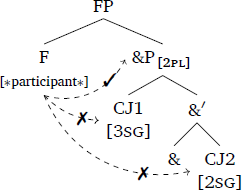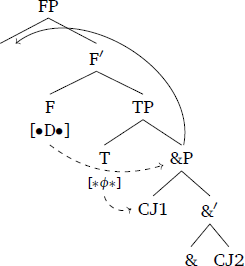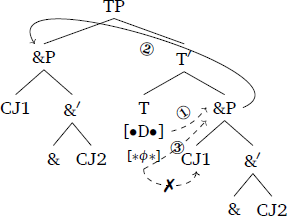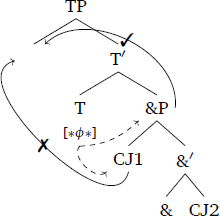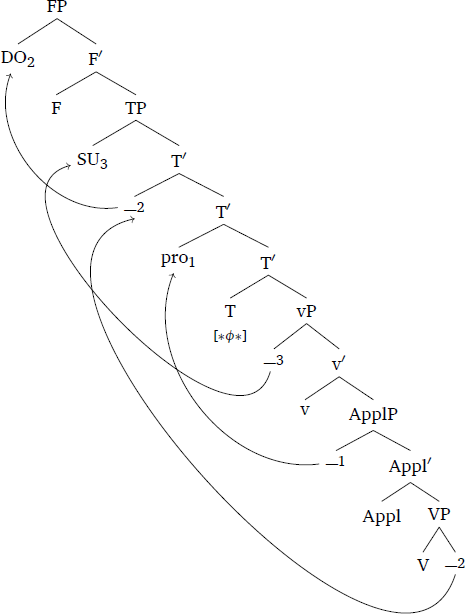1 Introduction
The phenomena clitic doubling (CLD), Person Case Constraint (PCC) and First Conjunct Agreement (FCA)1 have each figured prominently in the syntactic literature. With respect to CLD, of which an example is given in (1), the major challenge has been to account for the doubling, viz., the fact that the clitic and the doubled DP compete for a single theta-role/Case.
- (1)
- I
- the.nom
- Maria
- Mary.nom
- ton
- 3sg.m.acc
- aɣapai
- love.3sg
- ton
- the.acc
- Jorɣo.
- George.acc
- ‘Mary loves George.’ CLD Modern Greek
As for the PCC, this constraint restricts the combinations of person values indexed by phonologically weak indirect and direct objects of verbs, as in (2). The PCC literature has largely focused on accounting for the person restriction by means of ideally independently motivated syntactic principles.
- (2)
- *Tha
- fut
- tu
- 3sg.m.gen
- se
- 2sg.acc
- stilune.
- send.3pl
- ‘They will send you to him.’ 3>2 Modern Greek
Concerning FCA, an example being provided in (3), the debate here has focused on the precise configuration where the phenomenon is instantiated, including whether it can be captured in structural or linear terms, and how its derivation differs from resolved agreement with coordination.
- (3)
- Ftasate
- arrive.pst.2pl
- [esis
- 2pl.nom
- ke
- and
- eɣo]
- 1sg.nom
- tin
- the.acc
- iðja
- same.acc
- mera.
- day.acc
- ‘Y’all and I arrived the same day.’ Modern Greek
In this paper, we investigate configurations where the three phenomena interact. Such configurations are instantiated by what we will call first conjunct clitic doubling (FC CLD), exemplified in (4). Here, the preverbal clitic can double either the features of the entire coordination (resolved doubling) or just the features of the first conjunct, but not those of the second.2
- (4)
- { Se
- 2sg.acc
- / sas
- 2pl.acc
- /*tin
- 3sg.f.acc
- } iða
- see.pst.1sg
- [esena
- 2sg.acc
- ke
- and
- ti
- the.acc
- Maria]
- Mary.acc
- sto
- in.the
- parko.
- park
- ‘I saw you and Mary in the park.’ Modern Greek
We argue that this phenomenon has important consequences for our understanding of the three phenomena of interest. First, it provides evidence for theories of CLD solely based on Agree (as argued in more detail in Paparounas & Salzmann to appear). Second, FC CLD argues against theories of the PCC where movement is involved in the implementation of the PCC restriction and/or the generation of the clitic. Third, it favors theories of FCA that are based on rule ordering/labeling.
Our empirical focus throughout is on CLD in Modern Greek; our claims are therefore limited to this language and do not necessarily extend to other CLD languages.3
The paper is structured as follows. Section 2 introduces Greek clitic doubling in connection with the major theories of the phenomenon, before introducing FC CLD and offering a recap of Paparounas & Salzmann (to appear), arguing that this phenomenon provides evidence against movement in Greek clitic doubling. In section 3, we show that the PCC is at work in coordination, prompting us to explore the intersection of the PCC with FC CLD. Section 4 turns to theories of FCA, examining them in the light of our PCC data. Section 5 concludes.
2 Background: Evidence against movement-based analyses of clitic doubling
In this section, we present an abridged version of the argument from FC CLD against movement presented in detail in Paparounas & Salzmann (to appear). We begin by introducing the phenomenon of clitic doubling, and briefly illustrating the major approaches to the phenomenon. We then summarize the results of Paparounas & Salzmann (to appear), where the importance of FC CLD for theories of clitic doubling is highlighted: since most theories of clitic doubling capitalize on movement of one sort or another, they incorrectly rule out FC CLD as a violation of the Coordinate Structure Constraint. We conclude the section by providing additional, binding-theoretic evidence against movement in CLD and address previous (putative) arguments for movement.
2.1 Clitic doubling: The phenomenon and theories
2.1.1 The phenomenon
The focus of our interest here is clitic doubling as exemplified in (5a), where the doubled DP (here ton fititi) occupies an postverbal position. CLD is not to be conflated with clitic left dislocation (CLLD) (5b), where the doubled DP appears in a higher, left-peripheral position (see Angelopoulos & Sportiche 2021 for recent discussion). Greek is a clitic doubling language par excellence, and has figured prominently in debates on the phenomenon ever since the influential work of Anagnostopoulou (2003).
- (5)
- a.
- I
- the.nom
- Maria
- Mary.nom
- ton
- 3sg.m.acc
- aɣapai
- love.3sg
- ton
- the.acc
- fititi.
- student.acc
- ‘Mary loves the student.’ CLD
- b.
- Ton
- the.acc
- fititi,
- student.acc
- i
- the.nom
- Maria
- Mary.nom
- ton
- 3sg.m.acc
- aɣapai.
- love.3sg
- ‘The student, Mary loves him.’ CLLD
We will assume going forward that the doubled DP in CLD occupies an argument position and is thus not base-generated in a right-dislocated non-argument position. This conclusion is well-supported in Greek and beyond; among other crucial pieces of evidence, one finds the observation that Greek ECM subjects can be freely doubled, as in our (12) further below. See Angelopoulos (2019: 3) for further recent discussion.4
Space considerations prevent us from going into more detail on the conditions governing clitic doubling in Greek. We thus limit ourselves to noting the following points. Firstly, Greek CLD usually targets DPs high on the referentiality/topicality scale (Anagnostopoulou 2017a, see also section 2.2.4 below on information structure and WCO), but the precise conditions remain imperfectly understood, as quantified DPs and even indefinites can be doubled under certain conditions (see Angelopoulos 2019). Secondly, holding givenness/topicality constant, CLD is optional outside of intervention configurations (see sections 2.2.4., 2.2.5. below). Finally, CLD in Greek can target both direct and indirect objects, but not subjects (like other pro-drop languages, Greek lacks subject clitics); IO and DO doubling generally behave alike, with the exception that doubling of some IO, but not DO, third-plural DPs is difficult under specific circumstances (see Kouneli & Kushnir to appear, whose account is discussed briefly in Paparounas & Salzmann to appear). For more details on the distribution of CLD, we refer the reader to authoritative publications on CLD more generally (Anagnostopoulou 2017a) and on CLD in Greek specifically (Anagnostopoulou 1994; 2003; Angelopoulos 2019; Angelopoulos & Sportiche 2021).
2.1.2 Theories of clitic doubling
A major goal of theories of clitic doubling is to account for the emergence of the clitic: what mechanism ensures that the features of a DP occupying an argument position are indexed by a higher element thematically linked to that DP, and bearing the same case? Different answers to this question define different theories of CLD (see Anagnostopoulou 2017a for a recent overview).
In this section, we briefly summarize the major camps of CLD theories, before arguing that FC CLD points to just one of them, namely, the family of pure Agree-based approaches, as the correct one for Greek. Throughout, we illustrate the different analyses with trees for the structure of the simple clitic doubling example in (5a) above; to keep the exposition focussed on doubling, we do not show V-to-T movement and externalization of the subject DP in our trees.
In Big DP approaches, the clitic and the doubled DP underlyingly form a constituent: under the assumption that anaphoric dependencies are encoded derivationally, the two are coindexed precisely because they originate in the same big DP constituent. While approaches vary in terms of the precise internal structure they assign to the big DP (e.g., Uriagereka 1995; Nevins 2011; Arregi & Nevins 2012), they uniformly postulate that the clitic strands the DP in the course of the derivation by moving to a verbal projection, as schematized in (6), which is based on the structure of Uriagereka (1995: 81):
- (6)
In a different class of movement-based approaches, clitics are treated as secondary realizations of the D head introducing the doubled DP. In a first subtype of such an approach, the doubled DP undergoes A-movement to a peripheral position within the vP; the D head subsequently amalgamates downward with the verbal head whose specifier hosts the doubled DP, via rebracketing/m-merger (Harizanov 2014; Kramer 2014). Under this analysis, illustrated in (7) below, it is crucial that only the lower copy of the moved DP and the rebracketed D-head are realized. A-movement of the doubled DP is understood here as an instance of object shift/scrambling, given the doubled DPs’ semantic/pragmatic profile as specific/definite/topical. These approaches thus seem well-positioned to explain the interaction of clitic doubling with intervention and weak crossover, as detailed in section 2.2.4; however, as we argue in that section, the relevant facts are merely compatible with movement, but do not speak in favor of it.
A second subtype of the movement-based approach to CLD treats the clitic as arising by means of long head movement (e.g. Řezáč 2008; Roberts 2010; Preminger 2009; 2019; cf. Anagnostopoulou 2003 on feature movement). On this approach, an Agree relation between v and the object DP triggers movement of the head of that DP to v, with the clitic being the realization of the moved D head (Preminger 2019: 31–33). Both the moved D and the DP are realized at PF, yielding doubling (Preminger 2019: 20), see (8).
- (7)
- (8)
Despite important differences between them, the theories outlined thus far share movement as a crucial property.
The last type of approach treats clitic doubling as a type of object agreement. The idea goes back to at least Suñer (1988), where clitics are treated as base-generated agreement markers on the verb that enter a chain with the doubled argument DP. Under a more modern understanding of agreement, this type of approach can be recast by taking the clitic to be the realization of φ features which have been copied via Agree from the argument DP onto a functional head. Such an approach is sketched in (9) below, where we label the probing head as F for convenience (while v would be a possible alternative, we choose a higher head here for compatibility with our analysis developed below). Crucially, this approach involves only feature copying (or sharing), but does not involve movement.
- (9)
Before concluding this overview of approaches to clitic doubling, it is important to note that many analyses are hybrid in practice, incorporating components of more than one theory. Quite a few in fact include (A-)movement in addition to their arguably main ingredient.
For instance, the Big DP approaches in Uriagereka (1995) and Nevins (2011) involve an object-shift-like phrasal movement step preceding the attachment of the clitic to the verb via head movement or m-merger.
A-movement components are also found in agreement approaches. In Sportiche (1996), clitics are treated as independent functional heads in the extended projection of the verb that agree with the doubled DP, which undergoes covert movement to the specifier of the clitic head. More recently, in Angelopoulos (2019: 21), the doubled DP is said to undergo scrambling-like A-movement to the specifier of a functional head above vP. This movement is followed by Agree with a clitic head, which is situated below T (the A-movement step enabling the DP to become accessible to Agree).
2.2 FC CLD: Data and implications
2.2.1 FC CLD: Data
Against this background, consider firstly the fact that Modern Greek shows first conjunct agreement (FCA) with postverbal subjects: in (10a), a coordination of a singular and a plural noun can result not only in resolved 1pl agreement on the finite verb, but also in 2pl first conjunct agreement. In (10b), where the order of conjuncts is flipped, 2pl agreement has become ungrammatical, while 1sg agreement is now grammatical.
- (10)
- a.
- { Ftasate
- arrive.pst.2pl
- / ftasame
- arrive.pst.1pl
- / *eftasa
- arrive.pst.1sg
- } [esis
- y’all2pl.nom
- ke
- and
- eɣo]
- 1sg.nom
- tin
- the.acc
- iðja
- same.acc
- mera.
- day.acc
- ‘Y’all and I arrived the same day.’
- b.
- { Eftasa
- arrive.pst.1sg
- / ftasame
- arrive.pst.1pl
- / *ftasate
- arrive.pst.2pl
- } [eɣo
- 1sg.nom
- ke
- and
- esis]
- 2pl.nom
- tin
- the.acc
- iðja
- same.acc
- mera.
- day.acc
- ‘I and y’all arrived the same day.’
Crucially, Greek allows first conjuncts to not only trigger agreement on the finite verb, but also to be clitic-doubled. In (11a), alongside the resolved features of the entire coordination (3pl and default m), clitic doubling can index just the features of the first conjunct (3sg.m); it cannot index the features of the last conjunct (3sg.f). Once we reverse the order of conjuncts (11b), the masculine singular clitic becomes ungrammatical, and the feminine clitic grammatical.56
- (11)
- a.
- { Ton
- 3sg.m.acc
- / tus
- 3pl.m.acc
- / *tin
- 3sg.f.acc
- } iða
- see.pst.1sg
- [to
- the.acc
- Jani
- John.acc
- ke
- and
- ti
- the.acc
- Maria]
- Mary.acc
- tin
- the.acc
- iðja
- same.acc
- mera.
- day.acc
- ‘I saw John and Mary on the same day.’
- b.
- { Tin
- 3sg.f.acc
- / tus
- 3pl.m.acc
- / *ton
- 3sg.m.acc
- } iða
- see.pst.1sg
- [ti
- the.acc
- Maria
- Mary.acc
- ke
- and
- to
- the.acc
- Jani]
- John.acc
- tin
- the.acc
- iðja
- same.acc
- mera.
- day.acc
- ‘I saw Mary and John on the same day.’
In Modern Greek, person and number participate in (first conjunct) agreement, while person, number and gender participate in (FC) CLD. In both cases, person resolution proceeds according to the hierarchy 1st>2nd>3rd, and number resolution always leads to plural features. If the conjuncts mismatch in gender and agreement/doubling targets the entire &P, gender resolution takes place; gender resolution patterns are complex, see Adamson & Anagnostopoulou (to appear) for resolution in agreement with coordination, but in our examples will lead to masculine features.
Both FCA and FC CLD are only possible if the &P is in postverbal position. If it occurs in preverbal position, viz., Spec,TP for preverbal subjects or a left-peripheral A′-position as with preverbal objects, only resolved agreement/doubling are possible. We address this fact in section 4.3 below.
2.2.2 Implications for theories of CLD
Recall now that, as outlined above, most approaches to clitic doubling involve movement of some constituent in the generation/placement of the clitic. Crucially, under these approaches, FC CLD will lead to a violation of the Coordinate Structure Constraint (CSC, Ross 1967), which bans extraction of individual conjuncts and asymmetric extraction from individual conjuncts; FC CLD is thus incorrectly predicted to be ungrammatical under movement-based approaches (cf. Legate 2014; Kalin & Weisser 2019 for a similar argument for differential subject and object marking, respectively).
Under the Big DP analysis, movement of the clitic, associated only with the first conjunct, to the verb would amount to subextraction from a single conjunct, and thus a CSC violation. Similarly, an A-movement + rebracketing analysis would need to postulate asymmetric A-movement of the entire first conjunct to, e.g., Spec,vP, again in violation of the CSC. Finally, under the head-movement approach, there would be asymmetric head-movement of the D head of the first conjunct to the verb, an instance of subextraction also in violation of the CSC. Importantly, the CSC is not at stake in the first place under an Agree-based approach, which only involves feature-copying. Thus, FC CLD favors an Agree-based approach to Greek CLD, since only this type of analysis is compatible with the CSC.78
Further refinements to the argument against movement from the CSC are presented in Paparounas & Salzmann (to appear). There, we show that (i) the CSC holds in the relevant environments in Greek, viz., for A-movement of subjects to Spec,TP.; and (ii) our argument holds also under alternative conceptions of the Big DP hypothesis where the clitic head is generated outside of &P, and under more refined formulations of the CSC such as Bošković (2019; 2020), where minimal violations of the constraint are possible if the extractee originates at the edge of the first conjunct. We provide data based on coordinated ECM clauses with FC CLD of the ECM-subject in the first conjunct, which is crucially not at the edge as it is preceded by an adverb modifying the ECM clause, as shown in (12):
- (12)
- ðen
- neg
- { tin
- 3sg.acc.f
- / *ton
- 3sg.acc.m
- / *tus
- 3pl.acc.m
- } ekane
- make.pst.3sg
- kanis
- nobody.nom
- [avrio
- tomorrow
- ti
- the.acc
- Maria
- Mary.acc
- na
- comp
- erθi]
- come.pfv.3sg
- ke
- and
- [tin
- the
- epomeni
- next
- evðomaða
- week
- to
- the.acc
- Jani
- John.acc
- na
- comp
- fiji].
- leave.pfv.3sg
- ‘No-one made Mary come tomorrow and John leave next week.’
Examples like (12) would still be ruled out by the theory in Bošković (2019; 2020) and thus confirm that our argument based on the CSC stands.
2.2.3 Further arguments against movement: Binding
As argued in more detail in Paparounas & Salzmann (to appear), binding-theoretic considerations provide additional crucial evidence against the involvement of movement in Greek clitic doubling.
Data from Condition C and Condition A shows that clitic doubling neither feeds nor bleeds binding, providing strong support for the conclusion that the doubled argument (or, under the head-movement approach, parts of it) does not undergo movement. The configurations of interest are abstractly represented in (13), where it is always the lower argument (DP2) that is clitic-doubled: under A-movement based approaches to clitic doubling, then, DP2 is taken to undergo A-movement, and this is what is schematized in (13).
- (13)
- cli-V [DP2 …i]1 … [DP1 … ] … [DP2 …i]1
If, for instance, DP1 contains an unbound anaphor, movement of DP2 across it should create the correct binding configuration. Similarly, if DP1 is an R-expression and DP2 contains the same R-expression, a Condition C effect should be avoided if DP2 moves across DP1. Conversely, if DP2 is an anaphor bound by DP1, doubling of DP2 is predicted to destroy the binding relationship. Similar considerations hold for Condition C: if DP2 is an R-expresssion co-indexed with an R-expression embedded within DP1, movement of DP2 should trigger a Condition C effect.
Crucially, however, none of these predictions are borne out when we clitic-double the lower argument of the relevant examples. Beginning with Condition A, (14) shows that clitic-doubling the direct object does not enable this argument to bind a subject anaphor, contrary to the predictions of an account where doubling the direct object amounts to A-moving it to the edge of the verb phrase (see also Angelopoulos & Sportiche 2022: ex. 34b). Note that nominative anaphors are not independently ungrammatical in Greek (see Angelopoulos & Sportiche 2022: section 6.2).
- (14)
- *Tin
- 3sg.acc.f
- iðe
- see.pst.3sg
- o
- the.nom
- eaftos
- self.nom
- tisi
- 3sg.f.poss
- ti
- the.acc
- Mariai
- Mary.acc
- ston
- in.the
- kaθrefti.
- mirror
- ‘Herselfi saw Maryi in the mirror.’
(15) shows the other side of the same coin: clitic doubling the anaphor does not cause it to raise above its antecedent and violate Condition A.9
- (15)
- Ton
- 3sg.m.acc
- eðikse
- show.pst.3sg
- i
- the.nom
- Maria
- Mary.nom
- tu
- the.gen
- Yianii
- John.gen
- ton
- the.acc
- eafto
- self.acc
- tui
- 3sg.m.poss
- (ston
- in.the
- kaθrefti).
- mirror
- ‘Mary showed Johni himselfi in the mirror.’
The Condition A data thus shows that clitic doubling has no effect on binding; Condition C data reinforce this conclusion.
In (16a), where an IO R-expression c-commands another instance of itself in the DO, doubling the DO does not alleviate the Condition C violation; similarly in (16b) for the subject and the IO.
- (16)
- a.
- *Tini
- 3sg.f.acc
- eðikse
- show.pst.3sg
- i
- the.nom
- Maria
- Mary.nom
- [tu
- the.gen
- Jani]j
- John.gen
- [ti
- the.acc
- fotografia
- picture.f.acc
- tu
- the.gen
- Janij]i.
- John.gen
- ‘Mary showed Johnj the picture of Johnj.’
- b.
- *Tisi
- 3sg.f.gen
- eðikse
- show.pst.3sg
- [o
- the.nom
- Janis]j
- John.nom
- [tis
- the.gen
- manas
- mother.gen
- tu
- the.gen
- Janij]i
- John.gen
- to
- the.acc
- vivlio.
- book.acc
- ‘Johnj showed Johnj’s mother the book.’
Finally, clitic doubling also does not create a Condition C effect. A-movement-based accounts predict that the doubled version of (17a) should be a Condition C violation, since the doubled DO should have raised to c-command the IO; but this prediction is not borne out. (17b) patterns similarly.
- (17)
- a.
- (Toni)
- 3sg.m.acc
- eðikse
- show.pst.3sg
- i
- the.nom
- Maria
- Mary.nom
- [tis
- the.gen
- manas
- mother.gen
- tu
- the.gen
- Jorɣakii]
- little.George.gen
- [ton
- the.acc
- Jorɣaki]i.
- little.George.acc
- ‘Mary showed little Georgei to little Georgei’s mother.’ (context e.g. in a neonatal unit)
- b.
- (Toni)
- 3sg.m.acc
- koroiðepse
- mock.pst.3sg
- [i
- the.nom
- mitera
- mother.nom
- tu
- the.gen
- Petrui]
- Peter.gen
- [ton
- the.acc
- Petro]i.
- Peter.acc
- ‘Peteri’s mother made fun of Peteri.’
The binding data thus strongly suggest that the doubled DPs stay in situ: there is no evidence that the doubled DPs occupy anything but their base-generated positions for the purposes of binding.
Note that this observation calls into question the assimilation of clitic doubling in Greek(-type languages) to instances of overt A-movement such as A-scrambling in German: as we argue in more detail in Paparounas & Salzmann (to appear), a hallmark of A-scrambling and other bona fide instances of A-movement such as raising is that they can interact with Condition A and C, unlike Greek clitic doubling, which never does.
The fact that CLD does not affect binding follows straightforwardly under a pure Agree approach. Agree only copies phi-features and is well-known to have no effect on semantic interpretation (see, e.g., den Dikken 1995 on binding in expletive constructions).
2.2.4 Reanalyzing previous arguments for movement
In Paparounas & Salzmann (to appear), we discuss empirical arguments previously adduced in favor of movement: it has been argued that weak crossover (WCO) and defective IO intervention can be alleviated under clitic doubling. These effects of amelioration prima facie do not follow from an Agree-based account; but we show that the evidence can be insightfully reanalyzed.
It has been observed that clitic doubling repairs WCO violations in Greek: examples like (18), where the IO contains a bound pronoun and the DO is a quantified DP, are only grammatical if the DO is doubled. This effect has been interpreted as crucial evidence in favor of A-movement of the doubled DP in clitic doubling (Anagnostopoulou 2003).
- (18)
- *(Toi)
- 3sg.n.acc
- eðiksa
- show.pst.1sg
- [tis
- the.gen
- miteras
- mother.gen
- tui]
- 3sg.n.gen
- [to
- the.acc
- kaθe
- every
- peði]i
- child.n.acc
- (ston
- in.the
- kaθrefti).
- mirror
- ‘I showed every childito hisi mother in the mirror.’
In Paparounas & Salzmann (to appear), we argue that the alleviation observed under doubling is in fact properly independent of any movement, and is instead plausibly reducible to the information-structural correlates of doubling. It has independently been shown that information structural manipulations, especially givenness/D-linking/topicality of the binder, improves WCO violations (see Safir 2017: 23–24 for a recent overview and Eilam 2011: 150–160 for detailed discussion). Crucially, this also holds for Greek, where WCO can be alleviated under D-linking and focus, without any doubling.
(19) illustrates one such case. (19a) is a standard instance of WCO that is repaired by doubling (19b). Importantly, however, this instance of ungrammaticality can also be alleviated without doubling (or indeed any obvious instance of A-movement): the example improves considerably if the wh-phrase is D-linked (19c), and becomes perfect if D-linking is combined with focus on parts of the phrase containing the bound pronoun (19d).
- (19)
- a.
- ?*Pjoni
- who.acc
- misun
- hate.3pl
- ta
- the.nom
- peðja
- children.nom
- tui?
- 3sg.m.poss
- ‘*Whoi do hisi children hate?’
- b.
- Pjoni
- who.acc
- ton
- 3sg.m.acc
- misun
- hate.3pl
- ta
- the.nom
- peðja
- children.nom
- tui?
- 3sg.m.poss
- ‘*Whoi do hisi children hate?’
- c.
- ?[Pjon
- who.acc
- ðiasimo
- famous.acc
- iθopio]i
- actor.acc
- misun
- hate.3pl
- ta
- the.nom
- peðja
- children.nom
- tui?
- 3sg.m.poss
- ‘[Which famous actor]i do hisi children hate?’
- d.
- [Pjon
- who.acc
- ðiasimo
- famous.acc
- iθopio]i
- actor.acc
- misun
- hate.3pl
- ta
- the
- iðja
- same
- tui
- 3sg.m.poss
- ta
- the.nom
- PEðJA?
- children.nom
- ‘[Which famous actor]i do hisi own children hate?’
Importantly, since CLD is associated with givenness/topicality in Greek, WCO alleviation under doubling is a subtype of the more general phenomenon of information-structurally-based WCO alleviation, with no crucial role necessary for movement. From this perspective, information structure is the hidden third variable at play: it governs alleviation of WCO both under clitic doubling (19b) and without it (19c-d). This view, we argue, provides a more unified view of WCO alleviation in Greek compared to that offered by A-movement-based accounts of clitic doubling. Though accommodating (19b), these accounts have no way of linking this type of example to movement-free alleviation (19c-d), thereby missing the generalization that the information-structural correlates of doubling are precisely those that can be independently shown to alleviate WCO.
The second prominent argument in favor of movement comes from intervention effects in IO-nominative configurations, which were shown in Anagnostopoulou (2003: 45) to be alleviated by clitic doubling, see (20):
- (20)
- *(Tisi)
- 3sg.f.gen
- xaristike
- gift.pass.pst.3sg
- [tis
- the.gen
- Marias]i
- Mary.gen
- to
- the.nom
- vivlio
- book.nom
- apo
- from
- ton
- the
- Petro.
- Peter
- ‘The book was gifted to Mary by Peter.’
The effect of CLD in (20) follows if movement takes the intervener out of the way before T probes for the subject. We show in Paparounas & Salzmann (to appear) that the interaction in (20) can also be captured under an Agree-based approach and without movement if the notion of activity predicated of a DP refers not to case assignment but rather to whether the DP has been involved in φ-Agree. While not the majority view, this perspective on activity has been fruitfully applied in previous literature (see, e.g., Georgi 2013: 167, Kalin & van Urk 2015: 673, Oxford 2017). As long as the probe that generates the clitic is discharged before T probes, it can target the IO and deactivate it. Subsequent probing by T can skip the IO and access the low nominative. We argue that this activity-based view of intervention fares at least as well as the competing movement-based account.
Since these issues are addressed in great detail in the above-mentioned paper, we do not take them up any further here; we will briefly return to intervention in section 3.3 below where we evaluate the implications of a high clitic probe for theories of the PCC.
2.2.5 Distribution of clitic doubling
A final issue addressed in more detail in Paparounas & Salzmann (to appear) concerns the distribution of clitic doubling. Recall from the brief remarks in section 2.1.1 that doubling is most likely with highly referential/topical DPs, typically definites; although the situation in Greek is in fact more complicated (with even non-specific indefinites being capable of undergoing doubling in some cases). Any attempt to correctly circumscribe the range of DPs that can undergo doubling will also have to reckon with the issue of optionality: all things being equal, clitic doubling is hardly ever obligatory, even with the most doubling-eligible of DPs.
Approaches postulating A-movement of the doubled DP seem prima facie well-suited to addressing the distribution of doubling. Under such approaches, whether doubling occurs or not depends on whether the step of object shift that brings the clitic into the locus of m-merger or the domain of an Agree probe applies; if object shift does not apply (because the relevant DP does not bear the necessary features, related to topicality, for instance), then m-merger/Agree will not be able to ‘see’ the DP in its base position, for independent locality reasons. An approach based purely on Agree, on the other hand, owes an account of why certain DPs seem to not be eligible goals for the clitic-generating probe.
Before offering just such an account, we note that, contrary to the simple narrative just sketched, the distribution of clitic doubling is in fact just as much of a puzzle for movement-based theories as it is for Agree-based ones. A first reason for this is that any parallels between the A-movement step purportedly involved in doubling and bona fide cases of scrambling/object shift are at best imperfect and stand alongside striking binding-theoretic countervidence to the alleged parallelism, as argued earlier in this section. Secondly, for languages like Greek, movement-based accounts would need to invoke object shift even for elements otherwise expected to never undergo this process, since even (non-specific) indefinites can sometimes be doubled.
We thus consider the distribution of clitic doubling to be a puzzle for analyses of the phenomenon more generally, including movement-based ones; we will not attempt to shed new empirical light on this issue here, and will limit ourselves to showing how this kind of distribution can be implemented syntactically on our Agree-based account.
A proposal compatible with a pure Agree approach is the licensing approach to Differential Object Marking (DOM) by Kalin (2018; 2019). The underlying idea of this approach is that, in languages with DOM, only DPs with certain features need to be licensed, where licensing takes place via Agree. In Kalin (2019) this is technically implemented as follows: the features that require licensing, e.g, [specific], are associated with a so-called derivational time bomb; unless such a time-bomb is defused, viz., the feature it is associated with enters Agree, the derivation crashes. While the Agree probe on T is taken to be obligatory (because in the relevant languages, subjects agree irrespective of their semantic/pragmatic properties), an economy principle restricts the presence of a secondary licensor, viz., an Agree probe on v: a secondary licensor is only merged if necessary for convergence.
This logic can be directly extended to clitic doubling, which is thus treated as a variant of DOM. Concretely, objects with certain semantic/pragmatic properties, e.g. [def, top] etc., will carry a derivational time-bomb. A derivation will consequently only converge if there is a probe that agrees with this DP. If an object has no such feature, no licensing via Agree is required; a secondary licensor (in our case on T, see section 3.3 below) is thus not possible, and no CLD arises. Note that such an approach does not provide a deeper understanding of the distribution of CLD and has nothing to say about the optionality other than that the time-bomb is optional in some cases, which is little more than a restatement of the facts. This is, however, an explicit implementation of the distribution of CLD in syntactic terms that is compatible with an approach to CLD that solely relies on Agree. We will briefly come back to the optionality issue in our discussion of PCC repairs in section 3.4 below.
3 Clitic doubling and the PCC
The PCC (see Bonet 1991) enforces a person restriction in structures with two objects (an indirect (IO) and a direct object (DO)), where these objects are realized by phonologically weak elements, including agreement markers, clitics and weak pronouns (see Anagnostopoulou 2017b for a recent overview of the different types of the PCC). As shown in Anagnostopoulou (2003), the PCC in Greek is of the so-called strong type, ruling out local person direct objects in the presence of an indirect object (*X>1/2). An example is given in (21):
- (21)
- *Tha
- fut
- tu
- 3sg.m.gen
- se
- 2sg.acc
- stilune.
- send.3pl
- ‘They will send you to him.’ 3>2
The PCC literature mainly focuses on bare cliticization, partly because not all PCC-obeying languages show clitic doubling and because DP arguments are usually third person. We argue in what follows that this is a serious shortcoming: once the interaction of clitic doubling with the PCC is taken into account, interesting consequences arise for theories of the PCC.
Given that Greek allows the doubling of strong pronouns, the PCC can be shown to be operative not only when the arguments of the verb are represented by clitics as in (21), but also when they are full DPs undergoing clitic doubling as in (22), where a 3rd person IO and a second person strong pronoun DO are doubled:
- (22)
- *Tha
- fut
- tu
- 3sg.m.gen
- se
- 2sg.acc
- stilune
- send.3pl
- tu
- the.gen
- Jorɣu
- George.gen
- esena.
- you.acc
- ‘They will send you to George.’
Importantly, once the grammatical relations of the arguments are swapped (with a 2nd person IO and a 3rd person DO), the result is grammatical:
- (23)
- Tha
- fut
- su
- 2sg.gen
- ton
- 3sg.m.acc
- stilune
- send.3pl
- esena
- you.gen
- ton
- the.acc
- Jorɣo.
- George.acc
- ‘They will send George to you.’
Given our conclusion in section 2.2.2 that clitic doubling in Greek cannot involve movement of the clitic or (part of) the doubled DP, we can infer from the ungrammaticality of (22) that the implementation of the PCC also cannot make reference to movement of the elements involved in the generation of the clitics. We will show in the sections to come that this observation has far-reaching implications for theories of the PCC: since many of these involve movement as a central component in the implementation of the PCC, they can be ruled out based on our evidence against movement in CLD.10
We begin this section by providing the crucial data showing that FC CLD interacts with the PCC in the expected way: it leads to a violation of the constraint if doubling targets a 1st/2nd person first conjunct of a DO in the presence of a doubled IO.
We then survey existing approaches to the PCC and explore the consequences of FC CLD for them. We argue that most of them are incompatible with our data because they crucially involve movement in the generation of the clitic and/or the implementation of the PCC. Only a small number of approaches is compatible with our evidence against movement, namely, those PCC approaches that can rely solely on Agree.
Finally, we discuss two additional issues that arise once we consider the PCC and FC CLD in tandem. The first is the location of the clitic in the T region, which rules out even some of the purely Agree-based approaches to the PCC. The second one addresses the role of optionality of clitic doubling in PCC repairs and how it can be captured under an Agree account.
3.1 FC CLD and the PCC
Since no coordination is involved in (22), one cannot be completely sure that movement in the doubling of the DO is ruled out; we will therefore discuss the PCC in configurations that involve FC CLD, where the CSC rules out the possibility of movement.
We begin with ditransitive configurations where the direct object is a coordination of a second and a third person argument, examining whether FC CLD or resolved CLD are possible in these configurations. Consider firstly (24), where the direct object is a coordination of second and third person ([2+3]). In this case, there is no grammatical output under clitic doubling if a cliticized or clitic-doubled IO is present. Both FC CLD (which results in 2sg) and resolved doubling (which results in 2pl) lead to ungrammaticality:
- (24)
- *Tis
- 3sg.f.gen
- { se
- 2sg.acc
- / sas
- 2pl.acc
- / ton
- 3sg.m.acc
- } sistisa
- introduce.pst.1sg
- (tis
- the.gen
- Marias)
- Mary.gen
- [esena
- 2sg.acc
- ke
- and
- ton
- the.acc
- Petro].
- Peter.acc
- ‘I introduced you and Peter to Mary.’ 3>[2+3]
This situation is precisely what we expect if the PCC is at work in FC CLD: a local person DO clitic will violate the constraint once an IO clitic is present as well.
Interestingly, once we flip the order of conjuncts, yielding [3+2], a different result obtains: FC CLD is grammatical (since it gives rise to a third person clitic), while resolved CLD is not (as it yields a second person clitic):
- (25)
- Tis
- 3sg.f.gen
- { ton
- 3sg.m.acc
- / *sas
- *2pl.acc
- / *se
- 2sg.acc
- } sistisa
- introduce.pst.1sg
- (tis
- the.gen
- Marias)
- Mary.gen
- [ton
- the.acc
- Petro
- Peter.acc
- ke
- and
- esena].
- 2sg.acc
- ‘I introduced Peter and you to Mary.’ 3>[3+2]
Having examined the entire PCC paradigm, we have found that all configurations behave as expected: if the DO is [1/2+3], both FC CLD and resolved doubling lead to ungrammaticality, as in (24). If the DO is [3+1/2], resolved doubling remains ungrammatical, while FC CLD is grammatical, as in (25). This holds both for configurations where the IO is third person (as above) and configurations where it is a local person, as in the additional examples in (26)–(27). There is no PCC configuration where both resolved doubling and FC CLD are grammatical, and no configuration where resolved doubling is grammatical but FC CLD is ungrammatical: as long as the coordinated DO involves a local person, it is this person that will be indexed in the resolved double, yielding a PCC violation.
- (26)
- *Su
- 2sg.gen
- { me
- 1sg.acc
- / mas
- 1pl.acc
- / tin
- 3sg.f.acc
- } sistisan
- introduce.pst.3pl
- (esena)
- 2sg.gen
- [emena
- 1sg.acc
- ke
- and
- Maria].
- the.acc
- ti
- Mary.acc
- ‘They introduced me and Mary to you.’ 2>[1+3]
- (27)
- Su
- 2sg.gen
- { tin
- 3sg.f.acc
- / *mas
- 1pl.acc
- / *me
- 1sg.acc
- } sistisan
- introduce.pst.3pl
- (esena)
- 2sg.gen
- [ti
- the.acc
- Maria
- Mary.acc
- ke
- and
- emena].
- 1sg.acc
- ‘They introduced Mary and me to you.’ 2>[3+1]
Finally, if the DO involves a coordination of first and second person, both FC CLD and resolved CLD are ungrammatical:
- (28)
- a.
- *Tis
- 3sg.f.gen
- { me
- 1sg.acc
- / mas
- 1pl.acc
- / se
- 2sg.acc
- } sistisan
- introduce.pst.3pl
- (tis
- the.gen
- Marias)
- Mary.gen
- [emena
- 1sg.acc
- ke
- and
- esena].
- 2sg.acc
- ‘They introduced me and you to Mary.’ 3>[1+2]
- b.
- *Tis
- 3sg.f.gen
- { se
- 2sg.acc
- / mas
- 1pl.acc
- / me
- 1sg.acc
- } sistisan
- introduce.pst.3pl
- (tis
- the.gen
- Marias)
- Mary.gen
- [esena
- 2sg.acc
- ke
- and
- emena].
- 1sg.acc
- ‘They introduced you and me to Mary.’ 3>[2+1]
We thus see that the crucial factor is the composition of the DO coordination with respect to person features, as we expect if the PCC is at work in such constellations.
Conversely, in configurations where the PCC is not at stake, e.g., in (1/2/3>[3+3]) contexts, both FC CLD and resolved CLD of the DO are grammatical:
- (29)
- Su
- 2sg.gen
- { ton
- 3sg.m.acc
- / tus
- 3pl.m.acc
- } sistisa
- introduce.pst.1sg
- [ton
- the.acc
- Petro
- Peter.acc
- ke
- and
- ti
- the.acc
- Maria].
- Mary.acc
- ‘I introduced Peter and Mary to you.’ 2>[3+3]
Similarly, if the IO clitic is omitted (clitic doubling being largely optional, recall from above and see section 3.4 below), both FC CLD and resolved doubling are possible even with a [3+1/2] (or [1/2+3]) DO:11
- (30)
- { Ton
- 3sg.m.acc
- / sas
- 2pl.acc
- } sistisa
- introduce.pst.1sg
- (tis
- the.gen
- Marias)
- Mary.gen
- [ton
- the.acc
- Petro
- Peter.acc
- ke
- and
- esena].
- 2sg.acc
- ‘I introduced Peter and you (to Mary).’ [3+2]
Finally, as expected, if the IO involves a coordination of [1/2+3] or [3+1/2], both FC CLD and resolved doubling are possible in the presence of a doubled 3rd person DO.
- (31)
- { Su
- 2sg.gen
- / sas
- 2pl.gen
- / *tu
- 3sg.m.gen
- } ti
- 3sg.f.acc
- sistisa
- introduce.pst.1sg
- [esena
- 2sg.gen
- ke
- and
- tu
- the.gen
- Petru]
- Peter.gen
- ti
- the.acc
- Maria.
- Mary.acc
- ‘I introduced Mary to you and Peter.’ [2+3] > 3
The PCC thus restricts the possibilities of FC CLD or resolved CLD when the DO is a coordination. A violation always obtains if a local person value is copied from the DO in the presence of an IO clitic. No restrictions on FC CLD or resolved doubling obtain if the DO does not involve a local person. Similarly, in the absence of an IO clitic, either option is grammatical with a DO-coordination containing a local person value. Finally, there are no restrictions if the IO involves a coordination with a local person conjunct as long as the DO is 3rd person.12
3.2 Implications of FC CLD for theories of the PCC
In this section we will discuss the consequences of FC CLD for different implementations of the PCC. We will show, in the first subsection, that many approaches are incompatible with our data because they crucially require movement for (i) the implementation of the PCC restriction (intervention accounts, spec-head requirement) and/or (ii) the generation of the clitics. As we will see, while many implementations of the PCC involve Agree, this operation in itself is often insufficient to generate fully specified clitics because the probe(s) only copy a subset of the features of the objects. Consequently, as discussed in the second subsection, only a small set of approaches emerges as compatible with our data, viz., approaches where both the PCC and the generation of the clitic are implemented purely on the basis of Agree.
It should be pointed out that many approaches to the PCC only focus on pure clitic combinations and do not discuss clitic doubling. In what follows, we will try to extend these approaches to clitic doubling to be able to assess the consequences for our discussion. We will investigate representative instances of the relevant classes of approaches to the PCC, rather than providing exhaustive discussion of all existing approaches to the PCC.13
3.2.1 The problem of insufficient features and/or movement
A popular family of approaches treats the PCC as an intervention effect (Béjar & Řezáč 2003; Preminger 2009; 2019; Coon & Keine 2021, i.a.). The general idea underlying these approaches is that one probe has to license two internal arguments; given the limited features of the probe, not all person-number combinations are possible in double object constructions.
Concretely, in these analyses, the probe on v is split into a person and a number probe with the person probe invariably applying first. In a scenario with both an IO and a DO present, the structurally higher IO blocks person Agree with the DO. After person Agree between v and the IO has applied, the IO cliticizes, viz., head-moves to v. This removes the IO as an intervener (it is assumed that its trace is invisible). Thereafter, the number probe is discharged. Given that the IO no longer intervenes, the number probe on v can target the direct object, which subsequently also undergoes cliticization/head-movement to v. The basic configuration underlying intervention accounts is illustrated in (32), DO cliticization not being indicated for ease of representation (in what follows, we use the star notation for Agree probes that need to be discharged and bullet features for structure building; π = person, # = number):
- (32)
Next to movement of the IO and the split-probe, intervention accounts have a another component to implement the PCC-restriction. In Béjar & Řezáč (2003); Preminger (2009; 2019), the so-called Person Licensing Condition (PLC) requires first and second person arguments to enter person Agree. As a consequence 1st/2nd person direct objects will not be licensed in PCC configurations because the person probe on v has already been discharged through Agree with the IO. A third person direct object, however, is possible because its person feature does not require licensing. Since the split probe is located above both arguments and the person probe is discharged first, the person restriction only affects the DO.
In Coon & Keine (2021), this other component is different. The implementation of the PCC does not rely on the Person Licensing Condition, which they reject. Rather, in a 3>1/2 configuration, the PCC violation obtains because the person probe (in fact, different segments of it) agrees with both objects. The authors assume that the required ensuing clitic-movement operation fails as it would have to involve both clitics moving simultaneously, which by assumption is ruled out in this work (cf. also the implementation of the PCC in Arregi & Nevins 2012: 64–69).
Thus, in intervention accounts, the implementation of the PCC-restriction crucially involves movement of the arguments, which clashes with the evidence against movement discussed in sections 2.2.2 and 2.2.3.
Intervention accounts are also incompatible with our FC CLD data because they crucially rely on movement for the generation of the clitics. Note that in these intervention approaches, the result of the Agree operation initiated by v, namely the features copied unto v, remains unrealized. In fact, the features copied from the objects would not be sufficient to obtain fully specified clitics given that person and number probe separately and interact with different arguments. With respect to the IO, it is usually assumed that either no features are copied from it (Béjar & Řezáč 2003: 54; Preminger 2009: 656–657; Preminger 2014: 50–54) or only the person feature is (Coon & Keine 2021). With respect to the DO, the failure to interact with the person probe may at first seem unproblematic as long as 3rd person is interpreted as the absence of person. However, note that clitics in Greek are also specified for gender, which none of the PCC probes probe for. Thus, no gender feature is copied onto v in these approaches. Therefore, even if a person feature is copied from the IO and a number feature from the DO, v will lack the features necessary to realize fully specified clitics. Both the IO and the DO clitic must consequently arise in a different way; in a clitic doubling scenario, this will require one of the three movement-based approaches discussed in section 2.1.2 above; the approaches just mentioned in fact assume head-movement. However, this is clearly not compatible with the result obtained above, viz., that clitic doubling cannot involve movement: recall that FC CLD is possible with both coordinated IOs and DOs. Note that even if Agree were to generate fully specified clitics in these approaches, e.g., by employing different/more complex probes, they would still not be compatible with our FC CLD data since movement of the IO is a crucial component of the intervention account: without movement of the IO, the DO cannot be accessed.
Thus, intervention accounts of the PCC are incompatible with our data for two reasons: they require movement both for the implementation of the PCC and the generation of the clitics.14
The problem with Agree not copying sufficient features to generate fully specified clitics also arises in approaches where movement as such is not crucial in the implementation of the PCC. In one such approach, Anagnostopoulou (2003: 286–291), v also bears probes for person and number with [person] probing first. The PCC arises because once person features have been copied from the IO to v, only the number feature remains on v to Agree with the DO; under the assumption that the absence of person-Agree results in third person, the DO is consequently restricted to third person, while local person DOs cannot be licensed. Intervention is not an issue in this approach because the IO is assumed not to have a (accessible) number feature, which is why the number feature on v can target the DO across the IO. The basic configuration underlying this PCC-implementation is shown in (33):
- (33)
As in the intervention approaches, since Agree only involves partial feature copying from the objects, this will not be sufficient to generate IO and DO clitics specified for person, number and gender. Rather, Anagnostopoulou (2003: 211–215) proposes that in a clitic doubling scenario, the clitics arise via feature movement to T, which in modern terms would be recast as head-movement. Consequently, to obtain fully specified clitics, the approach crucially requires movement after all and is therefore also incompatible with our evidence against movement in clitic doubling.15
The problem with insufficient features copied via Agree also arises in the approach by Pancheva & Zubizarreta (2018: 1299–1306). In this approach, the relevant probes are on Appl, which introduces the IO and undergoes person-Agree with both the IO in its specifier and the DO within its VP complement. Appl is assumed to have a valued interpretable person feature [+proximate], which agrees with the IO. This feature is used to encode the fact that the IO must be a perspectival holder. Additionally, Appl has an unvalued uninterpretable person feature that agrees with the DO. The basic configuration underlying this approach is illustrated in (34):
- (34)
The implementation of the PCC restriction is handled by means of a constraint that stipulates that the person features on Appl must not be identical. Since the interpretable feature licensing the IO must be [+proximate] (to encode the IO’s role as a perspectival holder), the uninterpretable features copied onto Appl, viz., those copied from the DO, cannot contain [+proximate]. This restricts the DO to (obviative) 3rd person arguments since they bear [–proximate]. Like in the approach by Anagnostopoulou (2003), the PCC is not implemented by means of movement but by specific assumptions about the Agree probe on Appl. In this respect, the approach encounters no difficulty with our evidence against movement from FC CLD. However, even though the authors explicitly state (p. 1299) that their approach is compatible with the clitics either being the result of Agree or being present in the syntax already, in the latter case matching features on Appl, the fact that the [+proximate] feature on Appl is valued and interpretable implies that it cannot copy more (person) features from the IO. Consequently, Agree will not be sufficient to generate fully specified clitics if the IO is 1st or 2nd person, given that, in addition to [+proximate], they bear the features [+participant] and [+/– author]. Thus, the clitics in a CLD configuration have to arise in a different way in addition to Agree. Again, all other options discussed above are conceivable (Big DP, head-movement or A-movement + rebracketing). Since all these options require movement, this approach is also incompatible with our FC CLD data.16
The problem that Agree copies insufficient features to obtain fully specified clitics also arises in the approach by Foley & Toosarvandani (2022: 35). Because of its complexity, we will abstract away from many details and focus on the aspect that is of relevance to our discussion: this approach to the PCC differs from previous accounts in that Agree only targets the first/IO argument (followed by cliticization of the IO). The person restrictions affecting the DO are instead reanalyzed as restrictions on cliticization: it is proposed that the DO can cliticize onto the probe only if it contains a subset of the probe’s features (cf. Roberts 2010), which, simplifying somewhat, is relativized to probe for [participant]. Since this is not the case in a X>1/2 configuration (the notion of subset adopted in this approach is somewhat involved), such combinations are ruled out. In a X>3 configuration, however, the DO does contain a subset of the probe’s features because third person matches the probe’s values in a specific sense: it does not match any of them, but the empty set also qualifies as a subset of every set. Regardless of the merits of these restrictions on cliticization, it should be clear that the Agree operation alone will not be sufficient to generate fully specified DO clitics given that there is no feature copying from the DO. Consequently, this approach (which admittedly does not discuss clitic doubling) will require an additional mechanism to obtain the clitic in a CLD configuration (Big DP, head movement, A-movement + rebracketing). Again, these implementations all require movement and are thus incompatible with our FC CLD data.
All the approaches surveyed so far were shown to be incompatible with our evidence against movement because the Agree operations involved did not copy enough features from the objects to generate fully specified clitics. However, one can also find the reverse problem: there are approaches where Agree as such is sufficient to generate fully specified clitics but where movement is necessarily involved in the implementation of the PCC. In Baker (2011: 885), the person restriction is implemented as follows. By assumption, agreement in person requires a spec-head relationship. In a double-object configuration, v can probe twice but has only one EPP-feature and therefore attracts the closest goal, the IO, with which it can agree fully, viz., also in person. Subsequent Agree with the DO cannot be in person given the lack of a spec-head-relationship. Thus, v only agrees in number (and possibly gender) with the DO; hence, under the assumption that third person corresponds to the absence of person, DOs are limited to third person. The basic logic of the approach is illustrated in (35):
- (35)
The Agree operations initiated by v here would be sufficient to generate fully specified clitics (given that v can probe twice), and as such this analysis would require neither a Big DP nor a derivational account. However, since the approach requires movement of the IO to Spec,vP for person agreement to be possible, it is not compatible with our FC CLD data after all (recall that the IO can also involve a coordination, see ex. (31)).
Table 1 provides an overview of the approaches discussed in this subsection focusing on the components that require movement (viz., the generation of clitics or the PCC):17
Movement components in approaches to the PCC.
| intervention | A (2003) | P&Z (2018) | F&T (2022) | B (2011) | |
| mvmnt in PCC restriction | + | – | – | – | + |
| mvmnt in generation of clitics | + | + | + | + | – |
3.2.2 Compatible Agree approaches
In the approaches discussed in the previous section, a problem arises in the context of our FC CLD data because these approaches require (i) a movement approach for the generation of the clitic and/or (ii) movement of the objects in the implementation of the PCC restriction. Unlike in these approaches, there are a few Agree-based approaches to the PCC that can generate fully specified clitics while not requiring movement at all. They are thus compatible with the FC CLD data and more generally with our evidence against movement.
Nevins (2007: 296) proposes a multiple Agree approach where the probe on v targets both objects simultaneously. Here, the PCC restriction is implemented by means of restrictions on Agree. In languages displaying the strong version of the PCC, probing for person is relativized to contrastive values of [author]. In (3>1/2) configurations, a violation obtains because a third person argument has a non-contrastive value for [author] (author is only contrastive in the context of [+participant]). It thus acts as an intervener between v and the DO and multiple Agree fails given a stipulated condition on contiguous Agree. In X>3 configurations, no issues arise because here it is the lower argument, the DO, that bears a non-contrastive value for [author]. Consequently, this does not affect the interaction between v and the IO and no violation of contiguous Agree obtains. The basic configuration underlying this approach is illustrated in (36):
- (36)
Combinations of local persons (1>2/2>1) are ruled out by an additional condition called Matched Values, which is violated in this case because there are conflicting contrastive values for [author]. Thus, since the clitics arise purely via Agree and the PCC is implemented by means of restrictions on probing, the approach is compatible with our evidence against movement of the objects.18
Another approach compatible with our FC CLD data is Adger & Harbour (2007: 25–26). In this approach, v agrees with the IO, while Appl agrees with the DO. Appl is specified to select an IO bearing [participant], which includes 1st and 2nd person arguments as well as animate third person arguments; this rules out inanimate third person IOs. The PCC restriction is implemented as follows. A stipulation prevents Appl from probing for features that it requires for its specifier (cf. Pancheva & Zubizarreta 2018); consequently, given that Appl selects a specifier bearing [participant], it cannot probe for [participant], but only for number. This limits DOs to 3rd person arguments (third person resulting from the absence of [participant]). If it were to probe for [participant] and Agree with a local person DO, the IO would have to be inanimate, resulting in an uninterpretable structure. The basic configuration presupposed in the approach is shown in (37):
- (37)
While the approach is discussed in the context of clitics only, it would be compatible with an Agree-only approach to clitic doubling since, having two phi probes, it can generate fully specified (IO) clitics (the absence of [participant] on the DO clitic will result in 3rd person) and does not involve movement of the objects in the implementation of the PCC.19
The last approach that can generate fully specified clitics by means of Agree is Deal (to appear). Here, the probe has a so-called interaction condition for φ, which means it agrees with all objects bearing phi-features. This, in principle, allows the probe to interact with and copy features from several arguments. Probing stops once the probe’s satisfaction condition is obtained: in the PCC context, the probe is satisfied once it encounters the feature [participant]. The probe is located on Appl and first targets the DO within VP. Thereafter, the search space of Appl is extended to include the IO in its specifier (cf. the cyclic Agree approach by Béjar & Řezáč 2009). The basic configuration assumed in the approach is shown in (38):
- (38)
In a PCC-obeying context, e.g., 2>3, the probe will first copy the φ-features from the 3rd person DO. Since the probe is not yet satisfied, it continues to probe and targets the local person IO in its specifier and copies the features from there, too. This results in fully specified phi-feature sets. A PCC violation obtains if the DO already satisfies the probe, viz., if it contains [participant]. The probe is deactivated and no clitic IO can be licensed (the assumption being that clitics can only be generated via Agree). Since this approach does not involve movement in either the generation of clitics or the implementation of the PCC, it is compatible with our FC CLD data.20
Thus, of the eight types of approaches surveyed so far, only three are compatible with our evidence against movement of the objects. This is because they use Agree to generate fully specified clitics and implement the PCC by means of constraints on this operation itself.
3.3 Location of the clitic probe and consequences for theories of the PCC
As shown in the previous subsection, only Agree-based theories of the PCC are compatible with our evidence against movement. In this subsection, we address another important challenge for approaches to the PCC, viz., the surface position of the clitic. As we will see, it implies a high structural position for the clitic probe. This is an issue that has received rather little attention in the literature; but as we will see, it has wide-ranging ramifications for theories of the PCC in that it further narrows down the number of approaches compatible with the Greek PCC facts.
In many PCC languages, including Modern Greek, the clitics attach to the finite verb and thus surface in the T-region. Interestingly, as we have seen, most approaches to the PCC locate the probe involved in implementing the PCC restriction low, either on Appl or on v. To capture realization in the T-region, one may appeal to verb movement to T, dragging along the features of the clitic on v/Appl. However, this will not work in compound tenses, where the clitics attach to the auxiliary, which is not connected to the lexical verb, and thus the putative location of the clitic probe, via movement, see e.g., Angelopoulos & Sportiche (2021: ex. 31a):
- (39)
- an
- if
- o
- the.nom
- Petros
- Peter.nom
- to
- 3sg.n.acc
- içe
- had
- iði
- already
- ðjavasi
- read.3sg
- [to
- the.acc
- vivlio]
- book.n.acc
- ‘if Peter had already read the book …’
Therefore, the surface position of the clitic remains unexplained in approaches where a low position of the clitic probe is a necessary component of the implementation of the PCC. This clearly rules out the approaches by Adger & Harbour (2007) and Deal (to appear) (and also Pancheva & Zubizarreta 2018, which we have already ruled out because it requires movement to generate the clitics). In Adger & Harbour (2007), Appl is crucially involved since it has to interact both with the IO (through selection) and the DO (via Agree). With a probe in the T-region, it is no longer possible to implement the PCC-relevant restriction, which restricts Appl’s probing potential in the presence of an IO. The approach in Deal (to appear) is designed in such a way that the DO has to be targeted first because only then can the probe be deactivated before an IO is accessed. If the IO were accessed first, the probe would be incorrectly deactivated by any local person IO and no DO clitic could be licensed anymore. But since the IO c-commands the DO in Modern Greek in the unmarked surface order, which can be taken to be the base order (see Anagnostopoulou 2003: 137–143), a probe in the T-domain will necessarily first encounter the IO.21
Having ruled out other approaches to the PCC in section 3.2.1 because they require movement to generate fully specified clitics/implement the PCC restriction, this leaves us with the approach by Nevins (2007), where both objects are accessed simultaneously and nothing in principle rules out a probe in the T-region (we will turn to possible intervention by the subject presently). The number of approaches to the PCC compatible with our FC CLD data has thus been drastically reduced.
Given the morphology (the clitic is outermost in the verbal complex), one may want to place the clitic probe above T (see Angelopoulos & Sportiche 2021). However, recall from section 2.2.4 that clitic doubling voids intervention effects in IO-nominative configurations in Modern Greek. The interaction was captured in terms of Agree: Agree between the clitic probe and the IO was assumed to deactivate the latter and thus remove it as an intervener. For this interaction to be possible, one has to assume that the clitic probe has to be discharged before the probe that targets the nominative DP. Consequently, the probe cannot be located above T. Rather, it either has to be located on T or slightly below it.
Of course, a high clitic probe raises questions about potential intervention by an external argument in Spec,vP. If the clitic probe were located between T and vP (but still high enough to be dragged along by an auxiliary in compound tenses), it would, in (di-)transitive configurations, invariably first target the external argument/subject. This would in all likelihood lead to a crash given standard assumptions: if the probe copies features from the subject, subsequent probing by the nominative probe on T would arguably fail as it could not access the indirect object given that such probes are usually taken to be case-discriminating (an important component in the explanation of intervention effects), see Preminger (2014). Instead, to implement the interaction in IO-nominative configurations, we assume in Paparounas & Salzmann (to appear) that the clitic probe is a second (optional) probe on T (next to the probe agreeing with the nominative argument) and that the probes can be discharged in either order (but in certain configurations some orders of application may not lead to convergence).22
Given these assumptions about the location of the clitic probe and its ordering relative to the other probe on T that targets the nominative argument, intervention by the subject is no longer an issue. This can then be combined with an approach to the PCC as in Nevins (2007) and provide a coherent account of PCC effects under clitic doubling in Modern Greek. Thus, of the eight types of approaches surveyed in this paper, only one ends up being compatible with the totality of the relevant CLD and PCC facts in Modern Greek.23
Table 2 provides an overview of the extent to which the PCC approaches surveyed in this paper are compatible with the critical data addressed here, viz., whether they require (i) movement in the implementation of the PCC/the generation of clitics and (ii) a low location of the clitic probe. Approaches with any “+” in the table below are thus incompatible with the Greek CLD and PCC facts analyzed here.
Relevant properties of PCC approaches.
| interv. | Anag. | P&Z | F&T | Bak. | Nev. | A&H | Deal | |
| mvmnt in PCC restriction | + | – | – | – | + | – | – | – |
| mvmnt in generation of clitics | + | + | + | + | – | – | – | – |
| low probe | – | – | + | ? | + | – | + | + |
3.4 PCC repairs under Agree
In this subsection, we will discuss PCC repair by means of strong pronouns and how it can be treated under an approach to CLD that relies solely on Agree. We will argue that the two prominent proposals in the literature to capture repair by strong pronouns fail, and will show that the repair can be accommodated under an approach to CLD that is based on the idea that only certain DPs require licensing.
Recall from section 3 above that the PCC obtains with both pure cliticization and clitic doubling (of a strong pronoun):
- (40)
- a.
- *Tha
- fut
- tu
- 3sg.m.gen
- se
- 2sg.acc
- stilune.
- send.3pl
- ‘They will send you to him.’
- b.
- *Tha
- fut
- tu
- 3sg.m.gen
- se
- 2sg.acc
- stilune
- send.3pl
- tu
- the.gen
- Yiorɣu
- George.gen
- esena.
- 2sg.acc
- ‘They will send you to George.’
An important aspect of the PCC discussion is the treatment of repairs (see Řezáč 2011 for comprehensive discussion). In Greek, PCC violations can be repaired by using a strong pronoun as DO rather than a clitic pronoun, see Anagnostopoulou (2003: 312):24
- (41)
- Tha
- fut
- tu
- 3sg.m.gen
- stilune
- send.3pl
- esena.
- 2sg.acc
- ‘They will send you to him.’
This is prima facie unexpected under an Agree approach. If there is a clitic probe in the structure, one expects it to target the direct object and generate a clitic. There are two prominent types of accounts for this type of repair in the literature that at first sight could be applied in the case at hand. Firstly, one could assume that the strong pronoun is not a possible goal for Agree because it is actually a PP/has an FP shell around it (see, e.g., Béjar & Řezáč 2003: 54; Coon & Keine 2021: 683). Alternatively, the lack of clitic doubling of strong pronouns could be made to follow if the strong pronoun occupied a position not accessible to Agree (e.g., Preminger 2019), that is, if it did not undergo object shift and therefore was not close enough to the Agree probe.
Neither solution will work for Greek, though. With respect to the FP/PP analysis, recall firstly from earlier in section 3 that strong pronouns can be clitic-doubled, showing that they are, in fact, accessible to Agree. Secondly, strong pronouns freely trigger agreement on T, which would be unexpected if the person features of the pronoun were shielded from T by a PP:
- (42)
- Estiles
- send.pst.2sg
- (esi)
- 2sg.nom
- to
- the.acc
- ɣrama.
- letter.acc
- ‘You sent the letter.’
Thirdly, strong pronouns take appositions that agree in case, number and gender, (43), and they also agree with depictives in these features, (44). Such agreement is unexpected if the pronoun is enclosed in a PP shell.
- (43)
- ðen
- neg
- eprepe
- should.pst.3sg
- na
- comp
- (su)
- 2sg.gen
- po
- say.1sg
- esena
- 2sg.gen
- tu
- the.gen
- vlaka
- idiot.gen
- afto
- this.acc
- to
- the.acc
- mistiko.
- secret.acc
- ‘I shouldn’t have told this secret to you the idiot.’
- (44)
- Eðiksa
- show.pst.1sg
- eɣo
- 1sg.nom
- tis
- the.gen
- Marias
- Mary.gen
- protos
- first.m.nom
- to
- the.acc
- vivlio.
- book.acc
- ‘I was the first to show Mary the book.’
One could counter with respect to (43) that the purported PP in fact contains both the pronoun and the apposition, which thus agree in phi-features by virtue of occupying the same constituent. (44) clarifies that this cannot generally be the case. Given that the subject’s base position is above that of the indirect object, the subject and the depictive cannot be said to form a constituent at any point of the derivation. Consequently, the fact that the pronoun and the depictive agree in case and phi-features cannot be accounted for by positing a PP-shell encompassing the constituent containing the two, since such a constituent does not exist. Rather, for the two to agree in phi-features, there needs to be a c-command relationship between the two. This, however, is impossible if the strong pronoun is encapsulated in an FP/PP.
To summarize, all the above observations are completely unexpected if strong pronouns are contained in an FP/PP that makes them inaccessible to Agree.
With respect to relating the repair to a different structural position of the pronoun, viz., having it remain in a low structural position and therefore being inaccessible to the clitic probe, consider the following example. In (45), the DO consists of 2+3, while the IO is not clitic-doubled. The PCC is thus not at stake here. Crucially, doubling of the second person first conjunct inside the DO is optional (as is resolved doubling), viz., the example is also well-formed without any doubling of (parts of) the DO.
- (45)
- { Se
- 2sg.acc
- / sas
- 2pl.acc
- / *ton
- 3sg.m.acc
- } sistisa
- introduce.pst.1sg
- tis
- the.gen
- Marias
- Mary.gen
- [esena
- 2sg.acc
- ke
- and
- ton
- the.acc
- Petro].
- Peter.acc
- ‘I introduced you and Peter to Mary.’ 3>[2+3]
This optionality cannot obviously be related to different structural positions of the second singular pronoun on the surface given that the &P follows the indirect object regardless of whether there is a DO clitic or not. And given the CSC, movement of the DO pronoun in the presence of doubling is independently ruled out.
Consequently, both approaches to the PCC-alleviating effect of strong pronouns fail for Greek. Doubling of accusative strong pronouns simply seems to be optional. We will now show how the optionality of doubling and its consequences for repair can be handled under an Agree approach.
As discussed in section 2.2.5 above, the distribution of clitic doubling can be captured under an Agree-approach if only DPs with certain features require licensing, viz., bear a derivational time-bomb that must be Agreed with for the derivation to converge (Kalin 2019). In the case at hand, this implies that strong pronouns do not always bear a derivational time bomb (perhaps depending on their information structural properties). If a strong local person DO pronoun as in (40b) does bear a time-bomb, a secondary licensor, viz., a clitic probe, is necessary and the strong pronoun will be agreed with. In the presence of a third person IO that is also doubled (viz., also bears a derivational time-bomb), this will lead to a violation of the PCC (under various implementations of the PCC). If, however, the strong local DO pronoun is not associated with a time bomb, it will not be targeted by Agree and thus will not be clitic doubled and no PCC violation obtains as in (41).25
What makes strong pronouns different from bare cliticization as in (40a) is the optionality of doubling. If bare cliticization is analyzed as the doubling of pro (see, e.g., Preminger 2019; Angelopoulos & Sportiche 2021), one will need to assume that pro is necessarily associated with a derivational time-bomb (cf. also Stegovec 2020). Therefore, a PCC violation cannot be prevented in the relevant context.
In this section, we have discussed the implications of three crucial properties of Greek clitic doubling for theories of the PCC, viz., that doubling has to arise without movement, that the probe generating the clitic must be in the T-region and that PCC violations can be repaired by choosing not to double strong pronouns. As we have seen, these properties raise problems for nearly all previous approaches to the PCC. We have shown how the PCC facts can be made compatible with a pure Agree approach (by integrating a version of Nevins 2007), complementing the discussion in Paparounas & Salzmann (to appear).
4 The PCC and implications for analyses of FCA
In this section, we will explore the implications of FC CLD in PCC contexts for theories of FCA. We will first introduce the major theories of FCA; then we will discuss what happens once we combine these approaches with different types of theories of the PCC, viz., those that involve relativized probing and those that do not. We will see that, if relativized probing is involved, our data favors approaches to FCA based on rule ordering/labeling, while approaches based on equidistance undergenerate in some important cases. In the last subsection, we will address the fact that under CLLD, only resolved doubling is possible and discuss to what extent existing approaches to agreement in coordination can account for this fact.
4.1 Analyses of FCA
We will start by briefly reviewing three relevant approaches to FCA: the equidistance-based approach, the rule-ordering-based approach, and the labeling-based approach (see Nevins & Weisser 2019 for an overview). These approaches crucially differ with respect to the distribution of features within the &P; these differences, as we will see, have interesting implications in the context of the PCC.
We begin with approaches based on equidistance (e.g., van Koppen 2005; Bošković 2009). The crucial underlying assumption here is that the first conjunct and &P are equidistant to the probe. As a consequence, in a structure such as (46), the probe can in principle agree with either of the two goals (for ease of representation, probe and &P will be in a head-complement relationship in the tree diagrams to follow, even though, in actual fact, they would not be sisters for our data; rather, the clitic probe would be on T and the DO-&P would be a sister of V.).26
- (46)
Things work rather differently in the rule-ordering approach of Murphy & Puškar (2018), where only &P can be targeted by outside probes. Which features are found on &P depends on how the derivation proceeds within &P, and more specifically on the ordering between Agree (initiated by the coordination head) and Merge (of the two conjuncts).
Under this approach, there is both a downward Agree and an upward Agree probe, the downward Agree probe targeting the complement of &, i.e., the second conjunct, and the upward Agree probe targeting the specifier of &, i.e., the first conjunct. Resolved agreement obtains if the conjuncts are merged before the phi probes on the & head initiate probing. (47) below illustrates the derivation for resolved agreement (the features on the stack below & are discharged top-down; upward Agree could also apply before downward Agree, which will have an effect at the TP cycle, see the discussion in section 4.3 below on the asymmetry in the agreement possibilities between pre- vs. postverbal position). Since the conjuncts are both merged before Agree, both the downward and the upward Agree probe will find their respective goals and copy the phi-features from both conjuncts. The phi-features on & will then, modulo resolution, be present on &P.
FCA, on the other hand, emerges as an illusion: in this approach, FCA cannot be the result of the first conjunct being targeted by an external probe, since external probes can only ever Agree with the &P. As such, for FCA to emerge, the ordering of operations within &P must guarantee that &P ends up bearing the features of only the first conjunct. This situation arises when Agree between & and CJ2 is bled, viz., if downward Agree applies before the conjuncts are merged, followed by upward Agree initiated by &. Given this order, only the features of the first conjunct are copied onto &, see (48).27
- (47)
- (48)
The labeling-based approach by Larson (2013) has similar consequences for the presence of features on the maximal projection of the coordination: in this approach, non-initial conjuncts are treated as adjuncts to the first. By assumption, adjunction structures can, but need not, undergo labeling after concatenation. If there is no labeling, the entire &P cannot be targeted by syntactic operations, only the first conjunct can (it is assumed that only the first conjunct is concatenated with the verb). This results in FCA (49). If labeling does take place, the coordination can be targeted as a whole and resolved agreement obtains (50) (although it is not spelled out how this arises under an adjunction structure).28 Thus, as in the rule ordering approach, the two different agreement possibilities correspond to different syntactic derivations.29
- (49)
- adjunction unlabeled: FCA
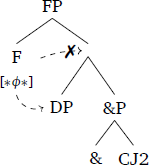
- (50)
- adjunction labeled: resolved agreement
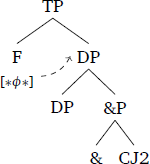
For our purposes, the crucial distinction between the approaches just surveyed is that under equidistance only one configuration is necessary for FCA and resolved agreement, while under rule ordering and labeling, the two agreement patterns correspond to two different derivations. We will see that this has important consequences in PCC contexts; in what follows, we will thus often group labeling- and rule-ordering-based approaches together to the exclusion of equidistance-based approaches.
4.2 Implications of FC CLD for theories of FCA
Several accounts of the PCC restriction involve relativized probing, viz., a probe specified to search for a goal with certain features (e.g., for [participant]). Of the movement-based approaches discussed in section 3.2.1, this holds for Coon & Keine (2021) and Foley & Toosarvandani (2022), but not for Anagnostopoulou (2003); Pancheva & Zubizarreta (2018); and Baker (2011); w.r.t. the movement-free approaches reviewed in section 3.2.2, this holds for Nevins (2007) and Deal (to appear), but not for Adger & Harbour (2007). We will now show that once relativized probing is adopted, the two types of theories of FCA make crucially different predictions.30
Under equidistance-based approaches, an external probe will be able to access both the features on the first conjunct and on &P. However, since the PCC probe is relativized, it will always target the goal that bears a local person feature. Consequently, in a 3>[3+1/2] configuration, it will necessarily target the resolved [1pl/2pl] feature on &P, as shown in (51) for 3>[3+2], which then leads to a violation of the PCC.
- (51)
More concretely, if we combine an equidistance approach with either Nevins (2007), Coon & Keine (2021) or Deal (to appear), FC CLD in 3>[3+1/2] scenarios is (incorrectly) ruled out as follows. In the multiple-Agree approach by Nevins (2007), the probe would agree with the 3rd person IO, the 1st CJ of the DO and &P. Since the 3rd person IO dominates the 2nd plural DO, a violation of the constraint Contiguous Agree obtains. In Coon & Keine (2021), different segments of the person probe would target different objects. The [pers] segment would target the 3rd person IO, while the [part] segment would target &P, which bears the local person value. This would lead to gluttony and thus ungrammaticality. In Deal (to appear), the probe could either target the 1st CJ of the DO and then, given that the probe would not yet be satisfied, &P; or just &P directly. Under either derivation, upon encountering the local person value on &P, the satisfaction condition of the probe is met and probing stops, thereby preventing the licensing of an IO-clitic.
Equidistance approaches thus undergenerate: they fail to generate the grammatical FC CLD option in this configuration (recall (25) above).
Under the rule ordering approach (Murphy & Puškar 2018), the two agreement patterns (FC CLD and resolved doubling) imply different derivations with different features on &P:
- (52)
- FC CLD
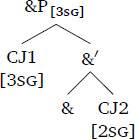
- (53)
- Resolved CLD
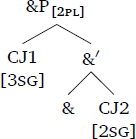
Recall that under this approach, an external probe can only access &P. This means that the two derivations will have different results: under the derivation resulting in resolved doubling in (53), the [2pl] will be copied and a violation of the PCC will obtain in a 3>[3+2] context. In the derivation with FC CLD as in (52), however, only the [3sg] feature is accessible, which leads to a grammatical result. Thus, under the rule ordering approach, the grammatical version in 3>[3+2] with FC CLD can be accounted for.
The same result obtains under the labeling approach (Larson 2013); depending on whether labeling takes place, either only the first conjunct is accessible, leading to FCA/FC CLD, or only the entire coordination (with resolved agreement/doubling) is. Thus, in a 3>[3+2] scenario, the derivation without labeling will derive the grammatical result, FC CLD.
The rule ordering approach and the labeling approach thus emerge as superior once relativized probing is adopted.31
Another possible advantage of Murphy & Puškar (2018) and Larson (2013) is that they restrict the search space. This is relevant in a multiple Agree approach as in Nevins (2007), the feature-gluttony approach by Coon & Keine (2021) or the interaction and satisfaction model by Deal (to appear), where a probe can agree with several goals for the same features. If these are combined with equidistance approaches, Agree will probably target both &P and the first CJ in some configurations. Importantly, some of these are well-formed double object construction scenarios, but the fact that probing can target both the 1st CJ and &P leads to various issues, potentially even a crash, thereby incorrectly ruling out such scenarios. For instance, under Deal (to appear), if the DO is [3+3], one would arguably expect the values of both the 1st CJ and &P to be copied onto the verb: since the probe is not satisfied upon agreeing with either goal, it targets the other as well; it will presumably then end up with features for three rather than two clitics (for a ditransitive verb). In Coon & Keine (2021), where the segments of the person probe can probe independently, it is conceivable that one of the segments agrees with the 1st CJ and the other with &P, thereby leading to feature gluttony even in grammatical configurations such as [3+2]>3. One can imagine a derivation where the segment [pers] agrees with the 1st CJ and the segment [part] with &P, leading to feature gluttony and thus ungrammaticality (although there would arguably be a grammatical derivation where both [pers] and [part] target &P). Gluttony could also incorrectly arise under number Agree with the DO if the probe has several segments and the DO consists of a coordination. In Nevins (2007), finally, an issue might arise in a [2+1]>3 scenario. Agree will possibly target both the 1st CJ and &P, which will lead to a violation of the constraint Matched Values, just like in 1/2>1/2 configurations involving distinct objects. Importantly, these issues only arise under equidistance. Under the rule-ordering and labeling approaches, there are no cases of unexpected ungrammaticality since only one feature bundle would be copied from the coordinated DO.
Importantly, the argument for rule ordering/optional labeling only obtains if relativized probing is involved. Without relativized probing, no issues arise. In Adger & Harbour (2007), Appl probes for number only; similarly, in Anagnostopoulou (2003) and Baker (2011), v only probes for number, and in Pancheva & Zubizarreta (2018), Appl probes for person, but not for a specific value. Under these approaches, the probe can access the features of the 1st CJ of the DO under equidistance and the grammatical result in 3>[3+2] configurations can be derived as well.32
4.3 Doubling and pre- vs. postverbal &Ps
So far we have only looked at doubling of &Ps that occur in postverbal position within the vP. Interestingly, under CLLD, only resolved doubling is possible; neither first/highest or last conjunct agreement is an option, irrespective of the order of conjuncts.
- (54)
- a.
- [Esena
- 2sg.acc
- ke
- and
- ti
- the.acc
- Maria]
- Mary.acc
- { *se
- 2sg.acc
- / *tin
- 3sg.f.acc
- / sas
- 2pl.acc
- }
- iða.
- see.pst.1sg
- ‘You and Mary, I saw.’
- b.
- [Ti
- the.acc
- Maria
- Mary.acc
- ke
- and
- esena]
- 2sg.acc
- { *se
- 2sg.acc
- / *tin
- 3sg.f.acc
- / sas
- 2pl.acc
- }
- iða.
- see.pst.1sg
- ‘Mary and you, I saw.’
The same pattern obtains with coordinated subjects. This pattern with subjects can be found in several languages of the world, see, e.g., van Koppen (2005), but it is not universal in that some languages can show first/highest or last conjunct agreement with coordinated subjects in preverbal position, see Nevins & Weisser (2019). As far as we can tell, little to no attention has been devoted to the pattern with displaced coordinated objects. For Greek, only CLLD is relevant given that focus fronting is incompatible with clitic doubling.
Since all other approaches to CLD discussed here involve movement and are consequently incompatible with FC CLD, they have nothing to say about the pre- vs. postverbal asymmetry.33 For an Agree-based approach, the question is what rules out a situation where Agree between the clitic probe on T (see section 3.3) and the first conjunct is followed by attraction of the entire &P by a head in the left periphery, as in (55). Note that, given the careful argumentation in Angelopoulos & Sportiche (2021), we assume that CLLD in Greek involves movement.34
- (55)
There are, as far as we can tell, two basic types of accounts for the pre- vs. postverbal asymmetry w.r.t. subject agreement.
As discussed in section 4.1, in the approach by Larson (2013), the difference between resolved vs. first/closest conjunct agreement arises from different structures, involving whether the coordination-by-adjunction structure is labeled or not. Only if it is labeled is the entire coordination accessible; unlabeled coordinations will be inaccessible by external probes for the purposes of agreement and, crucially, for movement. Thus, movement of the coordination is only possible under resolved agreement. Under an unlabeled structure, FCA obtains and the coordinated XP cannot be targeted for movement. Since FC CLD involves Agree, but not movement, this approach thus correctly rules out FC CLD with preverbal &Ps. Thus, in this approach, the position-dependent restrictions on agreement follow from the structure of the coordination. The two labeling options and consequences for movement are depicted in (56) and (57) (in what follows, we provide simplified trees with &P as the complement of T for ease of representation):
- (56)
- adjunction labeled
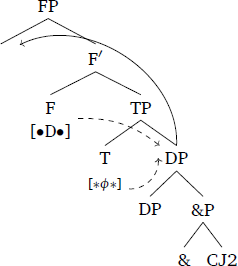
- (57)
- adjunction unlabeled
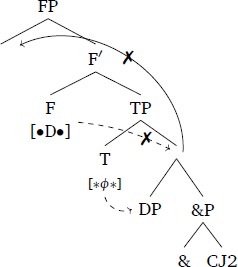
In another type of approach, the obligatoriness of resolved agreement in preverbal position arises from how movement of the &P interacts with Agree, with both operations crucially being initiated by the same head.
In van Koppen (2005), discussed above, the optionality of FCA and resolved agreement in postverbal position arises from the fact that the first conjunct and &P are equidistant to the probe. The obligatoriness of resolved agreement in preverbal position results from the assumption that Agree is delayed until after movement of the &P to the probe’s specifier. In addition, it is stipulated that, Agree being downward, it cannot access the internal structure of the lower copy of the &P and therefore only sees the features on &P, resulting in resolved agreement, as schematically depicted in (58).
- (58)
In Bošković (2009: 471), a principle is adopted according to which valuators determine pied-piping. In the case at hand, T can match either the first CJ or &P; pied-piping could thus in principle affect either. However, since the first conjunct cannot undergo movement in Greek (unlike in Serbo-Croatian), only &P is a possible target for movement. Consequently, &P is the only valuator that can be pied-piped, deriving the generalization that preverbal &Ps trigger resolved agreement in Modern Greek.
- (59)
In Murphy & Puškar (2018), the connection between preverbal position and resolved agreement is captured as follows. The basic idea is that only the derivation with resolved agreement converges under movement to Spec,TP, which is due to a constraint on uniform order of operations during the derivation: the order of operations at the TP level must be the same as at the &P level. We will start with resolved agreement, for which there are two possible orderings: Merge > ↓ > ↑ and Merge > ↑ > ↓. Starting with the ordering where downward Agree applies first, nothing special happens at the &P cycle: the features of both conjuncts are copied onto &. At the TP level, the question of movement arises. There are no separate EPP-features associated with the agreement probes in this system. Rather, movement can in principle always apply, but only if it has an effect on the outcome; in the current context, movement is licit if it feeds Agree but not if it bleeds Agree. By assumption, movement is always the first operation to apply at any cycle. In the derivation where downward Agree precedes upward Agree, movement is consequently blocked since it would bleed downward Agree. Therefore, &P remains in postverbal position. Since there are no Merge operations at this level, the first operation carried out by T is downward Agree, which copies the features from &P onto T; subsequent upward Agree, however, is bled (given that there is no goal in Spec,TP). This is thus the derivation for resolved agreement in postverbal position. The derivation is schematically depicted in (60):
- (60)
- resolved agreement postverbally
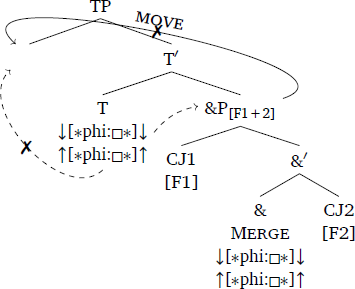
Under the ordering Merge > ↑ > ↓, there is no difference at the &P level: the features of both conjuncts are copied onto &P. However, things are different at the TP level: movement of &P is licensed since it serves to feed upward Agree. Subsequent downward Agree is bled. This is thus the derivation for resolved agreement in preverbal position.
- (61)
- resolved agreement preverbally
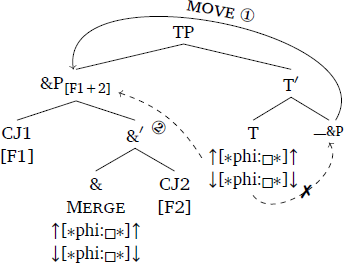
Turning to FCA, as shown in section 4.1 above, the ordering necessary to obtain FCA involves downward Agree preceding Merge followed by upward Agree, i.e. ↓>Merge>↑. As a consequence, only the features of the first conjunct are on &P. At the TP cycle, the question of movement arises again. Crucially, under the order for FCA, movement at the TP level is blocked because it would bleed downward Agree. Consequently, the coordinated subject remains in postverbal position. Then, the same order of operations that applied at the &P applies again at the TP level. Downward Agree by T will find the features on &P, viz., the features of the first conjunct. There is no separate Merge operation at this level and, finally, upward Agree is bled. The result is thus FCA in postverbal position the derivation of which is illustrated in (62):
- (62)
- FCA postverbally
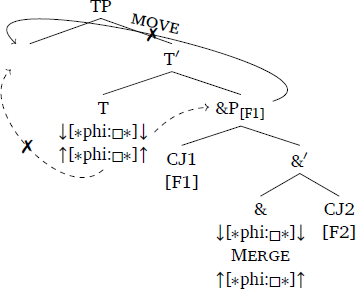
Importantly, to obtain FCA in preverbal position (viz., highest conjunct agreement), a different rule ordering would be necessary, viz. ↑ > ↓ > Merge, see Murphy & Puškar (2018: 1239–1241) for details. This order must be assumed to be unavailable in Modern Greek, unlike, e.g., in Serbo-Croatian.
Applying these approaches to the clitic doubling pattern in Modern Greek, there is one important challenge: as sketched in (55) above, and unlike in the previous derivations involving subject agreement, the CLLD-ed constituent targets a position in the left periphery which is different from the projection that hosts the clitic probe, namely, T (recall from section 3.3 above). Thus, at least prima facie, the theories that handle the generalization through the interaction of Agree and Move (van Koppen 2005; Bošković 2009; Murphy & Puškar 2018) do not work for our CLLD case. Rather, the facts only seem to be compatible with Larson (2013), where the necessity of resolved agreement in preverbal position is linked to the fact that only labeled &Ps can be moved. This restriction on movement holds quite generally and is crucially not tied to the probe effecting subject agreement. In the other approaches, nothing seems to rule out Agree between the clitic probe and the first conjunct and then having a head in the left periphery attract the entire &P, as sketched in (55) above.
Interestingly, though, Angelopoulos & Sportiche (2021: ex. 50, 69) in fact provide evidence that the CLLD-ed constituent moves to its left-peripheral A′-position via intermediate landing sites. They crucially show that a CLLD-ed DO containing a bound variable and an R-expression can reconstruct to a position below the subject (which is the binder of the variable) and above the dative clitic (which is conidexed with the R-expression inside the fronted DO):
- (63)
- [To
- the
- vivlio
- book.acc
- tu
- the
- juz
- son.gen
- tisk
- her.gen
- ja
- for
- ton
- the
- Minimalismo]i,
- Minimalism.acc
- kamia
- no
- miteralk
- mother.nom
- dhen
- not
- tuz
- 3sg.m.dat
- toi
- 3sg.n.acc
- echi
- have.3sg
- epistrepsi.
- returned.3sg
- ‘The book of [herk son]z about Minimalism, no motherk has returned to himz.’
Importantly, the authors take bare clitics to be doubling of pro; they show that this pro is interpreted roughly in the surface position of the clitic, viz., above vP. Within our assumptions, this could be Spec,TP or an outer specifier of vP.35 Thus, to account for the grammaticality of (63), one has to assume that CLLD proceeds via a position in between the subject and the dative clitic. A straightforward implementation involves movement of the DO via the specifier of T, with the IO-pro occupying a lower specifier of T and the subject a higher one, see (64):36
- (64)
Given such a derivation, all approaches that tie the obligatoriness of resolved agreement to the interaction of Agree and movement initiated by a single head, viz., van Koppen (2005); Bošković (2009); and Murphy & Puškar (2018), can be applied to the Greek CLLD-facts after all: intermediate movement in CLLD targets the projection hosting the probe that instantiates clitic-doubling/agreement.
We can therefore conclude that, given certain assumptions about the derivation of CLLD, the obligatoriness of resolved CLD in preverbal position is compatible with various existing accounts of the pre-/postverbal asymmetry, a positive result in our view.
5 Conclusion
In this paper we have explored the implications of FC CLD for a range of phenomena.
We have firstly summarized the results of Paparounas & Salzmann (to appear), which show that FC CLD argues in favor of Agree-based approaches to CLD and against approaches involving movement since the latter would incorrectly rule out FC CLD as a violation of the Coordinate Structure Constraint.
Secondly, we have shown that the PCC also holds in CLD configurations with coordination. Given that FC CLD rules out movement-based approaches to CLD, approaches to the PCC that require movement for the generation of the clitic/the implementation of the PCC fail as well. In addition, in many of these approaches, Agree only copies a subset of the arguments’ phi-features, which means that these probes are insufficient to generate fully specified clitics; moreover, the probe responsible for the PCC is often placed low in the structure (on Appl/v), but the Greek data suggests that the clitic-generating probe must be relatively high in the clause, in the T region. As a consequence, our data argues against a great many approaches to the PCC, essentially leaving just one proposal standing, namely Nevins (2007). We have also explored the consequences of an Agree approach for PCC-repairs; we have argued that they follow most straightforwardly under an approach that handles the distribution of CLD and instances of optionality by means of a licensing approach (Kalin 2019), which thus relates CLD to Differential Object Marking.
In the last part, we have shown that our PCC data in coordination distinguish between different approaches to FCA in that they favor the rule ordering and labeling approaches over equidistance-based approaches, at least when relativized probing is involved. Finally, we have addressed the asymmetry in the availability of FC CLD between postverbal (CLD) structures and preverbal ones (Clitic Left Dislocation). We have shown that the asymmetry can be captured by different theories of agreement with coordination provided that CLLD proceeds via an intermediate landing site, namely, the specifier of the head hosting the clitic probe.
Abbreviations
1 = first person, 2 = second person, 3 = third person, acc = accusative, comp = complementizer, f = feminine, fut = future, gen = genitive, m = masculine, n = neuter, neg = negative, nom = nominative, pass = passive, pfv = perfective, pl = plural, poss = possessive, pst = past, sg = singular.
Notes
- The Greek data do not adjudicate between first and closest conjunct agreement, since the phenomenon occurs only with the first conjuncts of coordinated postverbal subjects; we use the term FCA throughout for consistency. [^]
- This paper and Paparounas & Salzmann (to appear) are, to our knowledge, the first detailed investigations of FC CLD. The existence of the phenomenon has been noted before, albeit only in passing (Torrego 1995: 226, Schmitt 1998: 270–271 for Spanish; Bošković 2020: 145 for Spanish and Brazilian Portuguese). Angelopoulos & Sportiche (2021) do briefly mention that Greek FC CLD argues against Big DP approaches because of a possible Coordinate Structure Constraint (CSC) violation, but do not focus on the construction. Finally, van Craenenbroeck & van Koppen (2008: 208) note a related fact from pronoun doubling in Wambeek Dutch, offering also an account of why the construction does not violate the CSC that does not extend to FC CLD. [^]
- There is of course no reason to expect that FC CLD should not be available beyond Greek, and, in addition to the languages mentioned in fn. 2, the phenomenon in fact recurs elsewhere in the Balkan Sprachbund, namely in Macedonian (Steven Franks, p.c.), and Albanian (anonymous NELS reviewer, p.c.). Not having investigated this further, we cannot assess whether these languages pattern with Greek with respect to the data we focus on in this paper. FC CLD has been explicitly shown to be unavailable in Bulgarian, see Harizanov (2014: 1061, fn. 29). We thank an anonymous referee for pointing out that FC CLD has also been shown to be unavailable in Kuria (Bantu; Diercks et al. 2015). [^]
- Further evidence against the dislocation theory comes from the binding data discussed in section 2.2.3 below and the possibility of FC CLD introduced in section 2.2.1: in undisputable cases of right-dislocation (e.g., where the doubled DP clearly occupies a peripheral position in the clause), CLD must target the entire &P. Consequently, the possibility of FC CLD in our examples implies that &P must be in-situ. Thanks to an anonymous reviewer for prompting us to consider this point. [^]
- See Paparounas & Salzmann (to appear) for evidence that we are dealing with true DP coordination and not comitative expressions or conjunction reduction/stripping/gapping. With respect to the former, the coordinator + the second conjunct cannot be fronted together, unlike what we find with comitative prepositions. With respect to the latter, a clausal coordination + ellipsis parse can be ruled out by means of interpretive diagnostics targeting the number of events (sentences like nobody ever won the world championship and the olympic games in the same year, with FC CLD of the first conjunct, are incorrectly predicted to only accommodate a bieventive interpretation under a stripping parse); and by examples where FC CLD is compatible in the presence of collective verbs like transitive ‘gather’. [^]
- Judgments come from the first author and have been confirmed with four more native speakers of Greek. As is standard, we use diacritics like ‘*’ to indicate relative contrasts in acceptability rather than absolute judgments. For our core consultants, first conjunct agreement and doubling are judged as acceptable, although marked relative to their resolved counterparts; we have encountered no speaker for whom first conjunct agreement/doubling has the same status as last conjunct agreement/doubling, which is outright unacceptable for all speakers. Furthermore, to our knowledge, beyond being slightly more marked, FC CLD does not pattern differently to CLD of a non-coordinated DP in any systematic respect; for example, CLD can target both IOs and DOs, and so can FC CLD, all things being equal. Where CLD is subject to some restriction, FC CLD follows it as well; for example, CLD of plural IOs is sometimes difficult (see Kouneli & Kushnir to appear, mentioned briefly below (5)), and the same is true of doubling that targets the plural first conjunct of a coordinated IO. Alongside this general pattern, we find inter-speaker variation in more specific domains. Firstly, we have encountered one speaker for whom doubling of third-singular first conjuncts is unacceptable (Maria Kouneli, p.c.), and an anonymous referee for Paparounas & Salzmann (to appear) has noted that they themselves and speakers they have asked share this restriction. Though none of our consultants finds FC CLD fully degraded with third-singular first conjuncts, one consultant does find it worse than other cases of FC CLD; notably, the same consultant also finds third-singular-targeting FCA worse than other cases of FCA. More generally, whatever individual restrictions exist within a given consultant (including the native speaker author) seem to hold for both FCA and FC CLD, to the best of our knowledge. Note that, on our account, some amount of fine-grained inter- (and possibly intra-)speaker variability is expected for FC CLD, given that the same has been noted for FCA/agreement with coordination, as an anonymous Glossa reviewer notes (see, e.g., Marušič et al. 2015 for Slovenian). Secondly, we find structured variation with respect to the behavior of collective verbs, which for the native speaker author and one consultant freely tolerate FC CLD/FCA; for two other consultants tolerate FCA/FC CLD only in the presence of syntactic plurality; and for one speaker do not tolerate FCA/FC CLD at all. See Munn (1999) for similar correlations between syntactic plurality and collectivity in varieties of Arabic. We leave further exploration of these instances of variation for future work, taking care to highlight variation in the acceptability of our examples where appropriate. [^]
- The FC CLD facts are partly compatible with the approach in Angelopoulos (2019: 21), where A-movement targets a position below the clitic probe. FC CLD could thus potentially involve A-movement of the entire &P, followed by Agree with just the first conjunct. Note that such a derivation is not possible if A-movement targets the specifier of the clitic probe (as in Sportiche 1996), as only resolved doubling is possible in such configurations, see section 4.3 below. Importantly, an analysis where A-movement of &P precedes Agree with the first conjunct is precluded for the ECM-example in (12) below. In Baker & Kramer (2018: 1041–1042), the clitic is interpreted in a position adjoined to v; how the clitic ends up in this position is left open. If the clitic is base-generated in that position (an option the authors entertain), this analysis is also compatible with the CSC facts. But if this position is reached through movement, the by-now-familiar CSC issue will arise for this approach as well. [^]
- Given the existence of phenomena like first conjunct agreement/Agree-based doubling in languages that do not allow subextraction of first conjuncts, we take it to be the case empirically that feature copying is generally not subject to the CSC, unlike movement. As an anonymous referee points out, one might wonder why this is the case. Though it is beyond the scope of our concerns here to fully address this important question, it follows under prominent approaches to the CSC like Fox (2000), which, simplifying somewhat, requires the conjuncts to be semantically parallel. Under asymmetric extraction, this constraint will be violated (given that the extractee will bind a variable in only one conjunct). Agree will then escape the CSC by virtue of being a canonically uninterpreted operation. [^]
- While doubling of anaphors is judged grammatical by the native speaker author and our consultants, this is somewhat contested, see Baker & Kramer (2018: 1077) versus Angelopoulos (2019: 15); Angelopoulos & Sportiche (2021: section 5.3.2); Angelopoulos & Sportiche (2022: section 7). [^]
- If bare cliticization involves doubling of pro, e.g., Preminger (2019), then the same issue with movement might in principle also arise for examples like (21). However, FC CLD is not possible with bare cliticization (since the &-head requires overt conjuncts, pro cannot be one of the conjuncts). Therefore, the argument against movement from FC CLD cannot be straightforwardly extended to bare cliticization. This is why we focus on doubling of overt XPs. [^]
- This example sounds better with a PP dative, possibly owing to a garden path effect induced by the case-syncretic 2pl clitic; the same issue arises in ex. (31). This effect is orthogonal to our point here. [^]
- The fact that the choice between FC CLD and resolved CLD interacts with the PCC, an arguably bona fide grammatical phenomenon, seems to argue against the view that feature resolution in coordination is purely extra-grammatical (Lyskawa 2021). [^]
- Given robust evidence that the PCC is syntactic, see, e.g., Řezáč (2011); Preminger (2019), we will not discuss morphological approaches here. [^]
- Note that even if the CSC could be violated, these approaches would still encounter difficulties with the coordination data discussed above: In a configuration with FC CLD of an IO in the presence of a DO, recall (31), movement of the first conjunct out of the coordination would arguably not remove the entire IO-coordination as an intervener, at least not as long as there are features on &P. The number probe would arguably find &P first rather than the DO. As a consequence, no clitic for the DO could be generated; rather, another clitic for &P would arise. Thus, grammatical scenarios involving IO-coordination, e.g., [2+3]>3, could not be accounted for under these approaches even if the CSC were violable. [^]
- Since the approach does not address the PCC in the context of clitic doubling, the discussion is based on our interpretation of how the approach would have to be extended to this configuration. [^]
- Note that the authors do not address whether v probes for number and gender features; if not, this will be another reason why Agree is not sufficient to generate fully specified IO and DO clitics. [^]
- Other approaches to the PCC are incompatible with our data since these approaches are not obviously compatible with clitic doubling. In Stegovec (2020), clitics start out with valued gender and number features but crucially without valued person features. The person feature of a pronoun is valued via Agree with v, which bears a valued person feature. After Agree between v and the indirect object, v will be deactivated. Consequently, no person Agree with the DO will be possible, which is why it is restricted to third person (analyzed as a default). It is not quite clear how this approach could be extended to clitic doubling. Given that the clitics are taken to be independent syntactic elements that acquire features during the derivation, the only possibility seems to be the Big DP approach where the clitic is syntactically present from the start. However, it seems unusual for the clitic/pronoun associated with the Big DP to be unspecified for person features, assuming that normally, the clitic would agree with the DP in all phi-features; recall in this context that strong first and second person pronouns can be doubled in Greek. [^]
- Number and gender agreement are not discussed in Nevins (2007). Nevins (2011: 965–966) discusses number Agree, which in the cases considered leads to omnivorous agreement, which will not suffice to generate number on both clitics. If a probe relativized to contrastive [author] only finds a 3rd person argument, probing fails and 3rd person is inserted as a default, see Nevins (2011: 964). While Nevins (2007: 291) explicitly states that the clitics are the spell-out of Agree with the internal arguments, Nevins (2011) adopts a Big DP approach to clitic doubling, which requires movement after all and is therefore not compatible with our FC CLD data. [^]
- As far as we can tell, to rule out local person DOs in ditransitive clauses, the account also requires something like the Person Licensing Condition; thus, the DO’s person feature cannot be licensed/agreed with given that Appl can only probe for number. [^]
- To ensure the correct forms of the clitics, one arguably has to assume, in all three Agree-based approaches just discussed, that the case-values are copied along with the φ-features. Since the case values of both arguments, especially those of the DO, may not be determined until v enters the derivation, this probably requires a Case-checking approach if the probe is on Appl. Copying the case values along from the objects will be sufficient to distinguish these phi-features sets from those of the nominative argument and therefore ensure the correct realization at PF. In Paparounas & Salzmann (to appear), we provide more discussion of the morphological aspects of clitic doubling and how they can be treated under an Agree approach, including the cross-linguistically common syncretism between the determiner of the doubled DP and the clitics; we will therefore not dwell on this here. [^]
- Another potentially serious problem for approaches with the probe on Appl is the possibility of FC CLD with a coordinated IO as in (31) above. Depending on one’s assumptions (especially if the probe does not project and the goal has to c-command the probe), one would probably expect the probe to be only able to access &P but not parts of &P (given that only &P c-commands Appl). Things may be different if the probe projects to Appl′; however, as will be discussed in section 4.3 below, if &P is located in the specifier of the head it agrees with, FCA/FC CLD is very often not a possibility; it certainly is not in Greek. [^]
- Concretely, in IO-nominative configurations, the clitic probe has to be discharged first, in nominative-IO-configurations (ditransitive verbs), the probe interacting with the nominative argument has to be discharged first. [^]
- Note that the placement of the clitic and its implications for the position of the clitic probe is an irreducible property of clitic doubling in Greek (and other languages as well). Thus, even if one were to reject the argument from FC CLD, many approaches to the PCC would still have to be excluded because they are not compatible with such a high probe, certainly those where a low probe is a critical component, viz., Adger & Harbour (2007), Pancheva & Zubizarreta (2018), Deal (to appear), and presumably also Baker (2011), as this would entail movement of the IO to Spec,TP in double object constructions, which is, however, not attested in languages with a PCC-restriction. Conversely, intervention accounts and Anagnostopoulou (2003) are, in principle, compatible with a high probe given that the IO is accessed first (modulo some way to prevent intervention by the subject). [^]
- PCC violations cannot be repaired by replacing an IO clitic with a strong IO-pronoun because strong IO-pronouns independently require or at least strongly prefer doubling, see Anagnostopoulou (2003: 313), Tsakali (2006: 55–60). [^]
- If, as in most approaches to the PCC, the clitic-probe can interact with both objects, additional assumptions are necessary if only one of the objects is doubled (recall that a time-bomb is not a prerequisite for a DP to undergo Agree in Kalin 2018, cf. subjects). One possibility to allow doubling of just one of the objects is to restrict the clitic probe to probe only for objects with a time-bomb. [^]
- In van Koppen’s implementation, the values of both goals are copied onto the probe; which value is realized at PF depends on the specificity principle. While this derives the correct result for Dutch complementizer agreement, it does not generalize to languages like Modern Greek, especially when the choice between FCA/FC CLD and resolved agreement/doubling is optional and the specificity of the markers doesn’t play a role. For the sake of the argument, then, we will assume that under equidistance, either value can be copied. [^]
- Murphy & Puškar (2018: 1240–1241) show that the order ↓>↑> Merge can also lead to first conjunct agreement; we will ignore this possibility in what follows. [^]
- The assumption seems to be that in this type of structure, only resolved agreement is a possibility implying that the first CJ cannot be targeted. It is not discussed what this follows from. A possible reason is the A-over-A-principle, given that the higher DP dominates the first CJ. [^]
- Both the rule ordering approach in Murphy & Puškar (2018) and the labeling approach in Larson (2013) are confronted with difficulties once an &P that triggers FCA is compatible with elements that require a plural associate, such as reciprocals or collective verbs like ‘meet’. Not all languages allow this, but Greek does under FC CLD. Given that there are no plural features on &P under these approaches, it remains unclear how these plural-seeking elements can be licensed. This problem does not arise in equidistance-based approaches, where there is always a plural feature on &P. [^]
- Recall that in the previous section we have eliminated all approaches but Nevins (2007) to account for our FC CLD data in PCC contexts in Modern Greek. We will nevertheless discuss the implications for theories of the PCC more widely here since agreement in coordination generally has interesting implications for relativized probing that to the best of our knowledge have not received much attention. The relevance of the argument below also extends beyond the PCC as the issues are expected to arise whenever a relativized probe interacts with an &P. [^]
- As pointed out to us by Philipp Weisser (p.c.), the adoption of the approach in Murphy & Puškar (2018) may partially undermine our argument from FC CLD against derivational approaches, at least for the cases involving DP coordination. Under Murphy & Puškar (2018), the features of the first conjunct are present on the head of &P (and the phrase &P). This situation permits clitic doubling to arise in two ways: either through A-movement of the &P, followed by rebracketing of & with the verb; or through head-movement of & to the verb, which would not involve asymmetric extraction and thus incur no violation of the CSC. Crucially, however, our CSC-based argument employing coordinated ECM clauses in (12) would still stand: in these cases, no φ-features of the ECM subjects would be present on &P. As such, asymmetric movement would be necessary for the features of the first ECM subject to end up on the ECM verb. The predictions of the labeling approach are less clear to us in this context. Movement of/subextraction from the first conjunct would still affect a subpart of the coordination structure; we cannot assess how the absence of labeling relates to possibly CSC-violating movement. [^]
- Under the premise that the PCC is a syntactic phenomenon (cf., e.g., Preminger 2019; Řezáč 2011), the fact that the PCC interacts with FC CLD argues against 2-step Agree approaches to FCA where it arises via copying from the linearly closest DP at PF as in Marušič et al. (2015). [^]
- Under the Big DP hypothesis, one could imagine the clitic being generated outside the &P and agreeing with just the first conjunct. We show in Paparounas & Salzmann (to appear) that this alternative is eventually insufficient to handle FC CLD; but if this were an option, it would be unclear how to prevent FC CLD if the &P later moves on to an A′-position. The same issue arises in the other movement approaches: even if the CSC were not at issue, nothing would seem to rule out head-movement/A-movement from/of the first conjunct to v/Spec,vP followed by remnant A′-movement of &P. [^]
- The observation about CLLD would arguably be unsurprising if CLLD involved base-generation, as proposed in, e.g., Anagnostopoulou (1994). The clitic would be anaphoric to a discourse-prominent coordinated object; doubling of only part of the &P would not serve to resume the topic (cf. English: John and Mary, I like *her/*him/them). A variant of this approach for subject agreement can be found in the literature on Arabic, where the obligatoriness of resolved agreement in preverbal position has been linked to base-generation of the preverbal &P-subject in topicalized position with the subject position being occupied by a silent pronoun; given that pronouns always trigger full agreement in the relevant Arabic varieties, resolved agreement with preverbal &Ps is unsurprising. [^]
- Doubled pros thus behave differently than doubled DPs in that they do occupy a position that is different from the arguments’ VP-internal theta-position. For evidence that pro is actually interpreted in/reconstructed to a lower position, between T and the vP-internal subject position, see Angelopoulos & Sportiche (2021: ex. 62ff.). [^]
- To account for the surface position of the subject, one may have to assume that it moves to a slightly higher position above TP (especially if negation requires a separate projection). [^]
Acknowledgements
Earlier versions of this work were presented at WCCFL 39, Arizona (April 2021), GLOW 44 (April 2021), CLS 57, Chicago (May 2021), the workshop on Agreement in Multivaluation Constructions, Frankfurt (May 2021), the Penn Syntax Lab (October 2020/2021), and at the University of Leipzig (November 2022). We thank the audiences at these occasions for helpful discussion, in particular Luke Adamson, Elena Anagnostopoulou, Karlos Arregi, Željko Bošković, Daniel Gleim, Matt Hewett, Anke Himmelreich, Maria Kouneli, Ruth Kramer, Julie Legate, Gereon Müller, Johannes Mursell, Omer Preminger, and Philipp Weisser. The paper has greatly benefited from the comments of three anonymous reviewers. Finally, we are grateful to Yiannis Dakoumis, Efie Galiatsou, Alex Kalomoiros, and Konstantinos Paparounas for their judgments. All remaining errors are our own. Thanks also to the handling guest editor Johannes Mursell for the smooth handling of the reviewing process.
Competing interests
The authors have no competing interests to declare.
References
Adamson, Luke James & Anagnostopoulou, Elena. to appear. Interpretability and gender features in coordination: Evidence from Greek. In Proceedings of WCCL39, Somerville, MA: Cascadilla Proceedings Project.
Adger, David & Harbour, Daniel. 2007. Syntax and syncretisms of the person case constraint. Syntax 10(1). 2–37. DOI: http://doi.org/10.1111/j.1467-9612.2007.00095.x
Anagnostopoulou, Elena. 1994. Clitic dependencies in Modern Greek. Salzburg: University of Salzburg Doctoral dissertation.
Anagnostopoulou, Elena. 2003. The syntax of ditransitives: Evidence from clitics. Berlin: Mouton de Gruyter.
Anagnostopoulou, Elena. 2017a. Clitic doubling. In Everaert, Martin & van Riemsdijk, Henk (eds.), The Wiley Blackwell companion to syntax, second edition, 1–56. Oxford: Wiley-Blackwell. DOI: http://doi.org/10.1002/9781118358733.wbsyncom071
Anagnostopoulou, Elena. 2017b. The person case constraint. In Everaert, Martin & van Riemsdijk, Henk (eds.), The Wiley Blackwell companion to syntax, 1–47. Oxford: Wiley-Blackwell. DOI: http://doi.org/10.1002/9781118358733.wbsyncom101
Angelopoulos, Nikos. 2019. Reconstructing clitic doubling. Glossa: A Journal of General Linguistics 4(1)(118). DOI: http://doi.org/10.5334/gjgl.748
Angelopoulos, Nikos & Sportiche, Dominique. 2021. Clitic dislocations and clitics in French and Greek: From interpretation to structure. Natural Language & Linguistic Theory 39. 959–1022. DOI: http://doi.org/10.1007/s11049-020-09500-z
Angelopoulos, Nikos & Sportiche, Dominique. 2022. Treating Greek o eaftos mu as a regular anaphor: Theoretical implications. Ms. UCLA. lingbuzz/005653.
Arregi, Karlos & Nevins, Andrew. 2012. Morphotactics: Basque auxiliaries and the structure of spellout. Dordrecht: Springer. DOI: http://doi.org/10.1007/978-94-007-3889-8
Baker, Mark. 2011. When agreement is for number and gender but not person. Natural Language & Linguistic Theory 29(4). 875–915. DOI: http://doi.org/10.1007/s11049-011-9147-z
Baker, Mark & Kramer, Ruth. 2018. Doubled clitics are pronouns. Natural Language & Linguistic Theory 36(4). 1035–1088. DOI: http://doi.org/10.1007/s11049-018-9401-8
Béjar, Susana & Řezáč, Milan. 2003. Person licensing and the derivation of PCC effects. In Pérez-Leroux, Ana Teresa & Roberge, Yves (eds.), Romance linguistics: Theory and acquisition, 49–62. Amsterdam: John Benjamins. DOI: http://doi.org/10.1075/cilt.244.07bej
Béjar, Susana & Řezáč, Milan. 2009. Cyclic Agree. Linguistic Inquiry 40. 35–73. DOI: http://doi.org/10.1162/ling.2009.40.1.35
Bonet, Eulàlia. 1991. Morphology after syntax: Pronominal clitics in Romance languages. Cambridge, MA: MIT Doctoral dissertation.
Bošković, Željko. 2009. Unifying first and last conjunct agreement. Natural Language & Linguistic Theory 27(3). 455–496. DOI: http://doi.org/10.1007/s11049-009-9072-6
Bošković, Željko. 2019. On the coordinate structure constraint and labeling. In Stockwell, Richard & O’Leary, Maura & Xu, Zhongshi & Zhou, Z. L. (eds.), Proceedings of the 36th West Coast Conference on Formal Linguistics, 71–80. Somerville, MA: Cascadilla Proceedings Project.
Bošković, Željko. 2020. On the coordinate structure constraint, across-the-board movement, phases, and labeling. In van Craenenbroeck, Jeroen & Pots, Cora & Temmerman, Tanja (eds.), Recent developments in phase theory, 133–182. Berlin: De Gruyter Mouton. DOI: http://doi.org/10.1515/9781501510199-006
Coon, Jessica & Keine, Stefan. 2021. Feature gluttony. Linguistic Inquiry 52(4). 655–710. DOI: http://doi.org/10.1162/ling_a_00386
Deal, Amy Rose. to appear. Interaction, satisfaction, and the PCC. Linguistic Inquiry.
den Dikken, Marcel. 1995. Binding, expletives, and levels. Linguistic Inquiry 26(2). 347–354.
Diercks, Michael & Ranero, Rodrigo & Paster, Mary. 2015. Evidence for a clitic analysis of object markers in Kuria. In Kramer, Ruth & Zsiga, Elizabeth C. & Tlale Boyer, One (eds.), Selected proceedings of the 44th Annual Conference on African linguistics, 52–70. Sommerville, MA: Cascadilla Proceedings Project. DOI: http://doi.org/10.32473/sal.v44i1.107261
Eilam, Aviad. 2011. Explorations in the informational component. Philadelphia, PA: University of Pennsylvania Doctoral dissertation.
Foley, Steven & Toosarvandani, Maziar. 2022. Extending the person-case constraint to gender: Agreement, locality, and the syntax of pronouns. Linguistic Inquiry 53(1). 1–40. DOI: http://doi.org/10.1162/ling_a_00395
Fox, Danny. 2000. Economy and semantic interpretation. Cambridge, MA: MIT Press.
Georgi, Doreen. 2013. A relativized probing approach to person encoding in local scenarios. Linguistic Variation 12(2). 153–210. DOI: http://doi.org/10.1075/lv.12.2.02geo
Harizanov, Boris. 2014. Clitic doubling at the syntax-morphophonology interface. Natural Language & Linguistic Theory 32(4). 1033–1088. DOI: http://doi.org/10.1007/s11049-014-9249-5
Kalin, Laura. 2018. Licensing and differential object marking: The view from Neo-Aramaic. Syntax 21(2). 112–159. DOI: http://doi.org/10.1111/synt.12153
Kalin, Laura. 2019. Nominal licensing is driven by valued (phi-)features. Nordlyd 43(1). 15–29. DOI: http://doi.org/10.7557/12.4186
Kalin, Laura & van Urk, Coppe. 2015. Aspect splits without ergativity. Natural Language & Linguistic Theory 33(2). 659–702. DOI: http://doi.org/10.1007/s11049-014-9262-8
Kalin, Laura & Weisser, Philipp. 2019. Asymmetric DOM in coordination: A problem for movement-based approaches. Linguistic Inquiry 50(3). 662–676. DOI: http://doi.org/10.1162/ling_a_00298
Kouneli, Maria & Kushnir, Yuriy. to appear. Failed clitic doubling of plural indirect objects in Greek. In Proceedings of NELS 52, Amherst, MA: GLSA.
Kramer, Ruth. 2014. Clitic doubling or object agreement: The view from Amharic. Natural Language & Linguistic Theory 32(2). 593–634. DOI: http://doi.org/10.1007/s11049-014-9233-0
Larson, Bradley. 2013. Arabic conjunct-sensitive agreement and primitive operations. Linguistic Inquiry 44(4). 611–631. DOI: http://doi.org/10.1162/LING_a_00140
Legate, Julie Anne. 2014. Split ergativity based on nominal type. Lingua 148. 183–212. DOI: http://doi.org/10.1016/j.lingua.2014.06.002
Lyskawa, Paulina. 2021. Coordination without grammar-internal feature resolution. College Park, MD: University of Maryland Doctoral disseration.
Marušič, Franc & Nevins, Andrew Ira & Badecker, William. 2015. The grammars of conjunction agreement in Slovenian. Syntax 18(1). 39–77. DOI: http://doi.org/10.1111/synt.12025
Munn, Alan. 1999. First conjunct agreement: Against a clausal analysis. Linguistic Inquiry 30(4). 643–668. DOI: http://doi.org/10.1162/002438999554246
Murphy, Andrew & Puškar, Zorica. 2018. Closest conjunct agreement is an illusion. Natural Language & Linguistic Theory 36(4). 1207–1261. DOI: http://doi.org/10.1007/s11049-017-9396-6
Nevins, Andrew. 2007. The representation of third person and its consequences for person-case effects. Natural Language & Linguistic Theory 25(2). 273–313. DOI: http://doi.org/10.1007/s11049-006-9017-2
Nevins, Andrew. 2011. Multiple Agree with clitics: Person complementarity vs. omnivorous number. Natural Language & Linguistic Theory 29(4). 939–971. DOI: http://doi.org/10.1007/s11049-011-9150-4
Nevins, Andrew & Weisser, Philipp. 2019. Closest conjunct agreement. Annual Review of Linguistics 5(1). 219–241. DOI: http://doi.org/10.1146/annurev-linguistics-011718-012708
Oxford, Will. 2017. The activity condition as a microparameter. Linguistic Inquiry 48(4). 711–722. DOI: http://doi.org/10.1162/LING_a_00260
Pancheva, Roumyana & Zubizarreta, Maria Luisa. 2018. The person case constraint: The syntactic encoding of perspective. Natural Language & Linguistic Theory 36(4). 1291–1337. DOI: http://doi.org/10.1007/s11049-017-9395-7
Paparounas, Lefteris & Salzmann, Martin. to appear. First conjunct clitic doubling in Modern Greek: Evidence for Agree-based approaches to clitic doubling. Natural Language & Linguistic Theory, available at https://lingbuzz.net/lingbuzz/006960.
Preminger, Omer. 2009. Breaking agreements: Distinguishing agreement and clitic doubling by their failures. Linguistic Inquiry 40(4). 619–666. DOI: http://doi.org/10.1162/ling.2009.40.4.619
Preminger, Omer. 2014. Agreement and its failures. Cambridge, MA: MIT Press. DOI: http://doi.org/10.7551/mitpress/9780262027403.001.0001
Preminger, Omer. 2019. What the PCC tells us about “abstract” agreement, head movement, and locality. Glossa: a journal of general linguistics 4(1), 13. DOI: http://doi.org/10.5334/gjgl.315
Řezáč, Milan. 2008. Phi-agree and theta-related case. In Harbour, Daniel & Adger, David & Béjar, Susana (eds.), Phi theory, 83–129. Oxford: Oxford University Press.
Řezáč, Milan. 2011. Phi-features and the modular architecture of language. Dordrecht; New York: Springer. DOI: http://doi.org/10.1007/978-90-481-9698-2
Roberts, Ian. 2010. Agreement and head movement: Clitics, incorporation, and defective goals. Cambridge, MA: MIT Press. DOI: http://doi.org/10.7551/mitpress/9780262014304.001.0001
Ross, John R. 1967. Constraints on variables in syntax. Cambridge, MA: MIT Doctoral dissertation.
Safir, Ken. 2017. Weak crossover. In Everaert, Martin & van Riemsdijk, Henk (eds.), The Wiley-Blackwell companion to syntax. 2nd edition, Oxford: Wiley-Blackwell. DOI: http://doi.org/10.1002/9781118358733.wbsyncom090
Schmitt, Christina. 1998. Lack of iteration: Accusative clitic doubling, participial absolutes and have + agreeing participles. Probus: International Journal of Latin and Romance Linguistics 10(3). 243–300. DOI: http://doi.org/10.1515/prbs.1998.10.3.243
Sportiche, Dominique. 1996. Clitic constructions. In Rooryck, Johan & Zaring, Laurie (eds.), Phrase structure and the lexicon, 213–276. Dordrecht: Kluwer. DOI: http://doi.org/10.1007/978-94-015-8617-7_9
Stegovec, Adrian. 2020. Taking case out of the person-case constraint. Natural Language & Linguistic Theory 38(1). 261–311. DOI: http://doi.org/10.1007/s11049-019-09443-0
Suñer, Margarita. 1988. The role of agreement in clitic-doubled constructions. Natural Language & Linguistic Theory 6(3). 391–434. DOI: http://doi.org/10.1007/BF00133904
Torrego, Esther. 1995. From argumental to non-argumental pronouns: Spanish doubled reflexives. Probus 7. 221–241. DOI: http://doi.org/10.1515/prbs.1995.7.2.221
Tsakali, Paraskevi. 2006. The syntax and acquisition of pronominal clitics: A cross-linguistic study with special reference to Modern Greek. London: UCL Doctoral disseration.
Uriagereka, Juan. 1995. Aspects of the syntax of clitic placement in Western Romance. Linguistic Inquiry 26(1). 79–123.
van Craenenbroeck, Jeroen & van Koppen, Marjo. 2008. Pronominal doubling in Dutch dialects: Big DPs and coordinations. In Barbiers, Sjef & Koeneman, Olaf & Lekakou, Marika & van der Ham, Margreet (eds.), Microvariation in syntactic doubling, 207–249. Bingley: Brill.
van Koppen, Marjo. 2005. One probe – two goals: Aspects of agreement in Dutch dialects. Utrecht: LOT.

